Posts Tagged henry ford museum
OUT!: LGBTQ+ Visibility and Identity
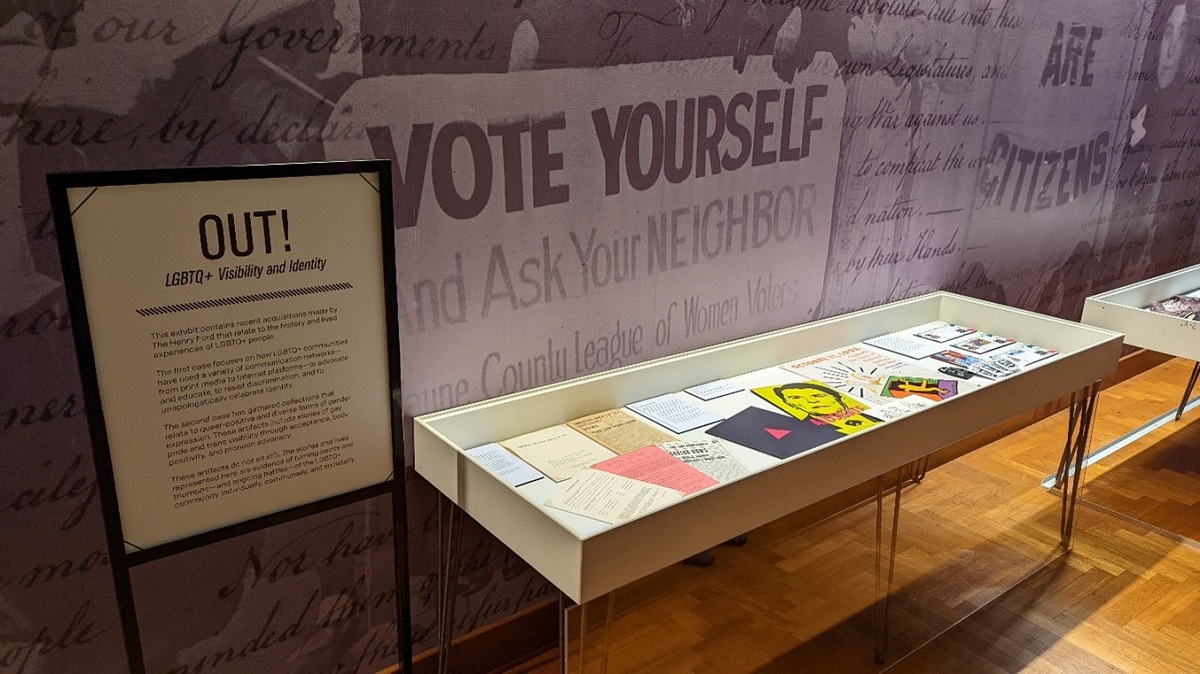
Photo by Kristen Gallerneaux/Katherine White
In 2022, The Henry Ford displayed a temporary exhibit, OUT!: LGBTQ+ Visibility and Identity, at Henry Ford Museum of American Innovation. The exhibit, co-curated by Kristen Gallerneaux and Katherine White and featuring items from The Henry Ford's collections, contained recent acquisitions that relate to the history and lived experiences of LGBTQ+ people.
The first theme explored in this exhibit was how LGBTQ+ communities have used a variety of communication networks—from print media to Internet platforms—to advocate and educate, to resist discrimination, and to unapologetically celebrate identity.
The second major theme gathered collections that relate to queer-positive and diverse forms of gender expression. These artifacts included stories of gay pride and trans visibility through acceptance, body positivity, and pronoun advocacy.
These artifacts do not sit still. The stories and lives represented in OUT!: LGBTQ+ Visibility and Identity are evidence of turning points and triumphs—and ongoing battles—of the LGBTQ+ community individually, communally, and societally.
Getting the Word Out
In the 1960s, LGBTQ+ people faced a largely unaccepting American society and legal landscape that restricted how they could express themselves. Queer bars and clubs were among the only private, “safe” spaces, for LGBTQ+ patrons but they were also easy targets for police, who harassed and arrested patrons. On June 28, 1969, New York City police raided the Stonewall Inn, a gay club in Greenwich Village. A riot ensued.
Queer bars and clubs also became sites of community and connection—even amidst persecution and harassment—and became fertile soil for the burgeoning queer liberation movement. LGBTQ+ newspapers were distributed in these spaces, broadcasting news unlikely to be shared in mainstream media. Print media like these unified queer/LGBTQ+ people in the fight for acceptance and equality through sharing manifestos, organizing protests, and recruiting members.
Today, we recognize the legacy of the Stonewall Riots as the genesis for the Pride marches that celebrate the LGBTQ+ community every June, in cities big and small across America. .jpg?sfvrsn=e6cd3601_2)
THF627212.jpg?sfvrsn=b2cd3601_2)
THF627336
These fliers were created by New York City’s chapter of The Mattachine Society, one of the oldest gay rights groups in America, in the months following the Stonewall Riot. They illustrate the urgency felt by the queer community in the wake of persistent and brutal police violence.
Raising Awareness
In the early and mid-1980s, activist collectives formed to raise awareness of HIV and AIDS. This advocacy was critical, since government and public health organizations initially refused to act or acknowledge the developing crisis. Misinformation about HIV and AIDS transmission was widespread, and so LGBTQ leaders and allies spoke up—demanding an end to negligence, access to testing, treatment options, and vetted public education about HIV prevention..jpg?sfvrsn=aacd3601_2)
THF179775.jpg?sfvrsn=9acd3601_2)
THF627370
The Silence=Death Collective’s “AIDSgate” poster condemns then-president Ronald Reagan’s lack of response to the AIDS epidemic. In 1981, the first AIDS cases in the United States; President Reagan did not recognize AIDS in a public speech until September 1985..jpg?sfvrsn=eecd3601_2)
THF627366.jpg?sfvrsn=86cd3601_2)
THF627364
Howard Cruse, author of the acclaimed graphic novel Stuck Rubber Baby, uses the slogan of the Gay Liberation Front in the top drawing above: “We’re here, we’re queer, get used to it!” The “Gay is Good” illustration mimics historical photographs of protestors at the 1969 Stonewall Uprising that were also referenced in the “Gay Liberation” poster by Su Negrin, Peter Hujar, and Suzanne Bevier.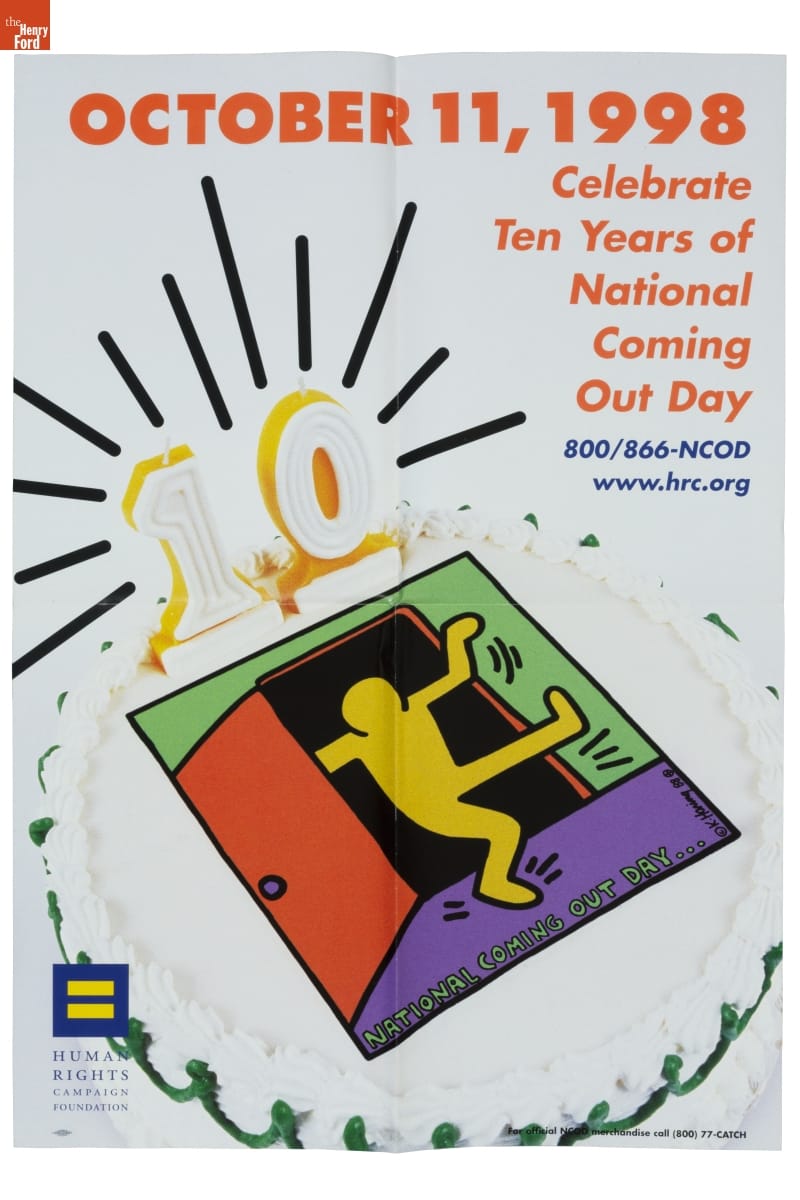
THF190487
In 1988, Richard Eichberg and Jean O’Leary founded Coming Out Day to provide resources for LGBTQ+ people wishing to publicly declare their identity. The pair believed that “coming out” would promote solidarity and acceptance while reducing homophobia. The Human Rights Campaign (an LGBTQ+ advocacy and political lobbying group) sponsors this event in the United States. This poster commemorates the 10th anniversary of the observance, which remains active in 2022. The logo of a person dancing their way out of a closet depicted on the cake on this poster references artist Keith Haring’s original NCOD logo.
Online Identity & Safe Spaces
Online platforms can act as digital “safe spaces” for LGBTQ+ community-building. Beginning with Usenet bulletin board systems in the 1980s and transitioning to LiveJournal, Twitter, and Tumblr in the 2000s, these sites can act as support networks for LGBTQ+ people—including those who live in isolated areas or in situations where openly exploring identity poses challenges AFK (away from keyboard). 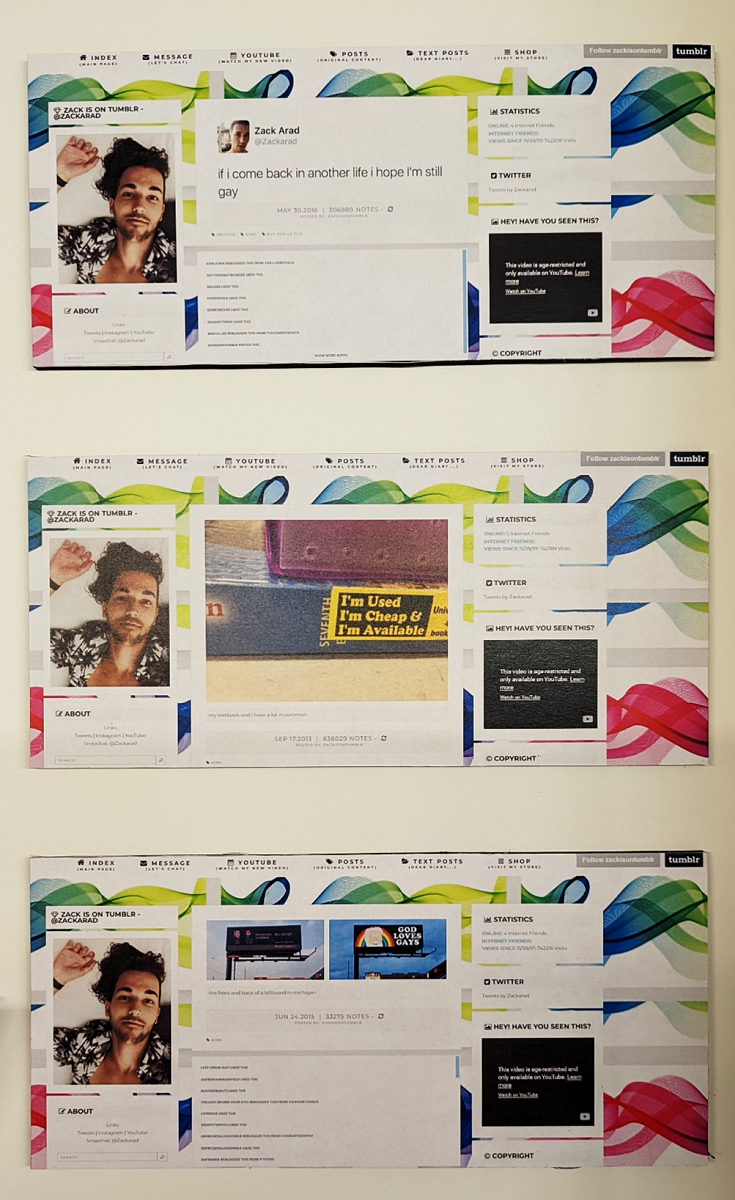
Photo by Kristen Gallerneaux/Katherine White
Zack Arad launched a microblog on July 21, 2010. Arad, who self-identifies as gay, has been active on social media since he was a teenager. His popular Tumblr blog and YouTube vlogs explore themes like gay pride, pop culture, humor, dating, and political issues.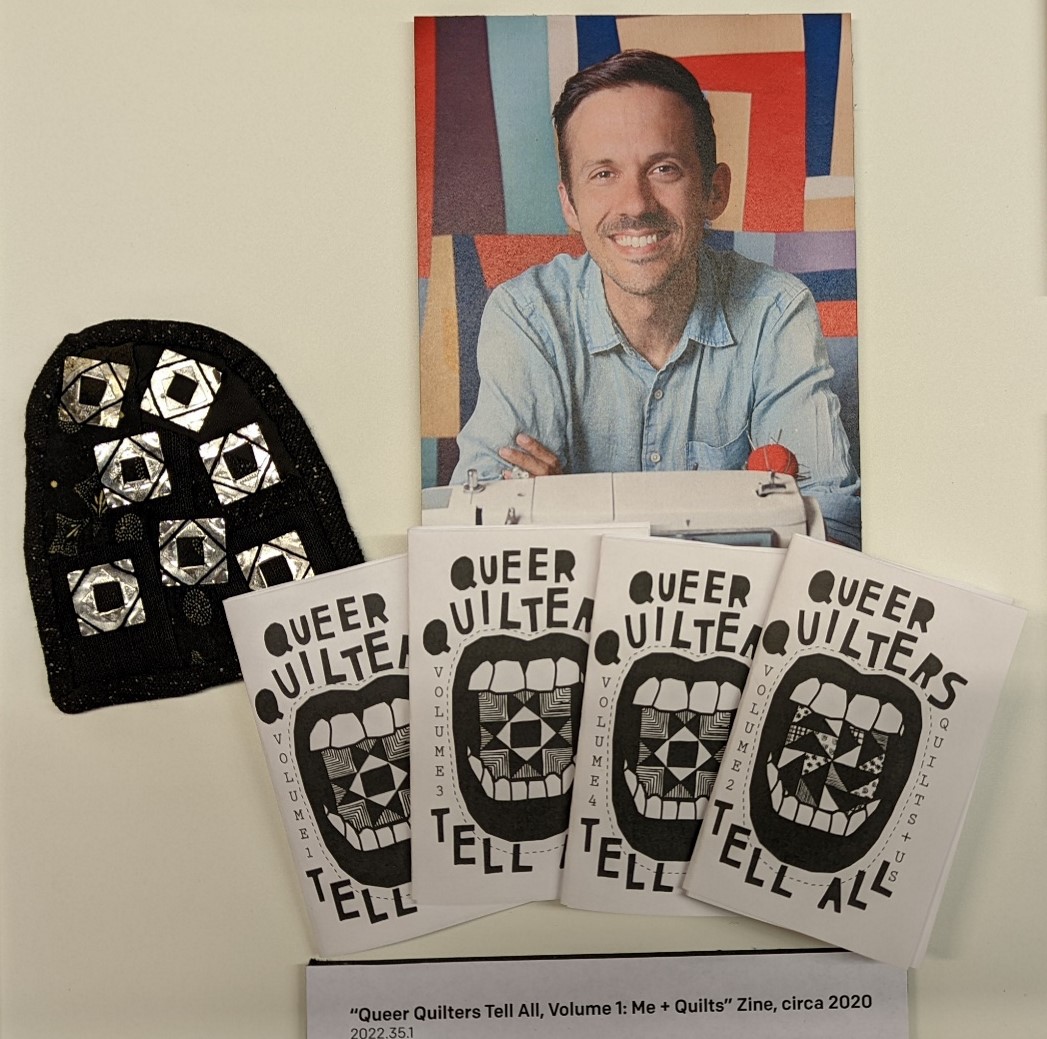
Photo by Kristen Gallerneaux/Katherine White
This “mini-quilt” was created by Zak Foster, a textile artist who identifies as gay and has a strong online following for their work, selling one-of-a-kind upcycled quilts on Etsy. With Grace Rother, Foster also created this collection of “zines,” and distributed them online “as a love offering … to all the queer folks in the quilting community.”
Identity & Solidarity
Buttons, patches, badges, and pins are consciousness-raising, inexpensive, quick to create, and able to be distributed widely. Wearing a button can be a method of activism. When simply being “out” as LGBTQ+ means possible danger and discrimination, choosing to wear a visible symbol of queerness is a courageous act. .jpg?sfvrsn=becd3601_2)
THF189705
The cap above was worn by a member of a California-based gay motorcycle club. Among the oldest gay organizations in the United States, these clubs emphasized hypermasculinity, which appealed to many gay men who had long been stereotyped as effeminate.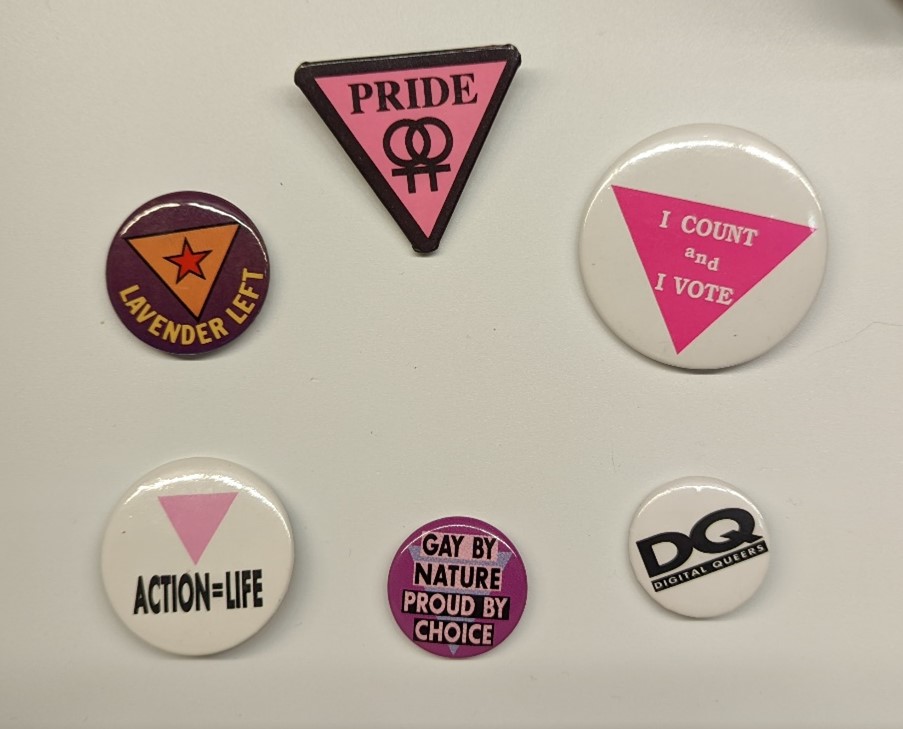
Photo by Kristen Gallerneaux/Katherine White
Many of the buttons featured here use symbols or terms that were once weaponized against the LGBTQ+ community but were later reclaimed. The inverted pink triangle, for example, has its roots in the Holocaust, when Nazis forced queer people to wear a pink triangle as a form of identification and persecution. By repurposing these symbols, a shared and recognizable language of identity and solidarity is created among LGBTQ+ people and allies.
Trans Acceptance
Transgender and nonbinary people have always existed, across time and in every corner of the world—just as have gay, bisexual, lesbian, and other queer communities. But acceptance by the broader world has been difficult to achieve. Even the early leaders of the LGBTQ+ equality movement pushed the transgender community to the fringes. For many transgender and nonbinary individuals, the realization that their gender identity does not align with their assigned-at-birth gender comes long before even their own acceptance and celebration of it.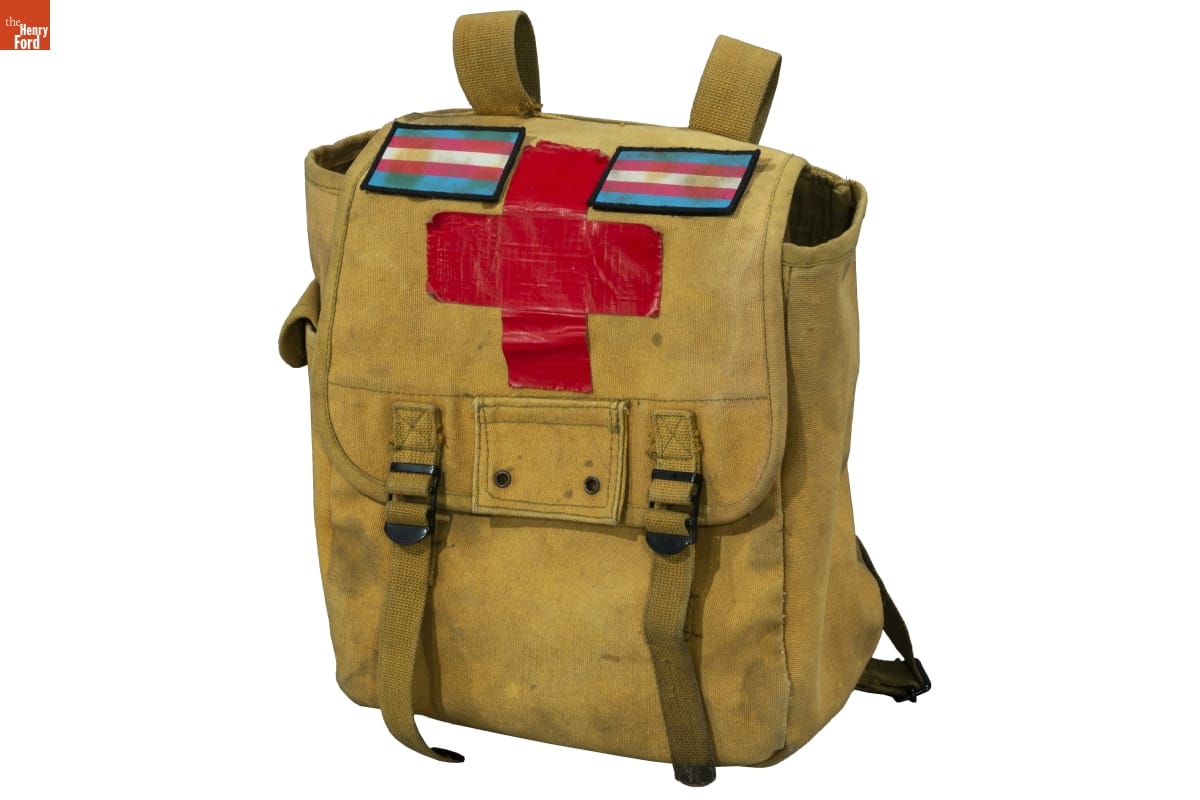
THF190453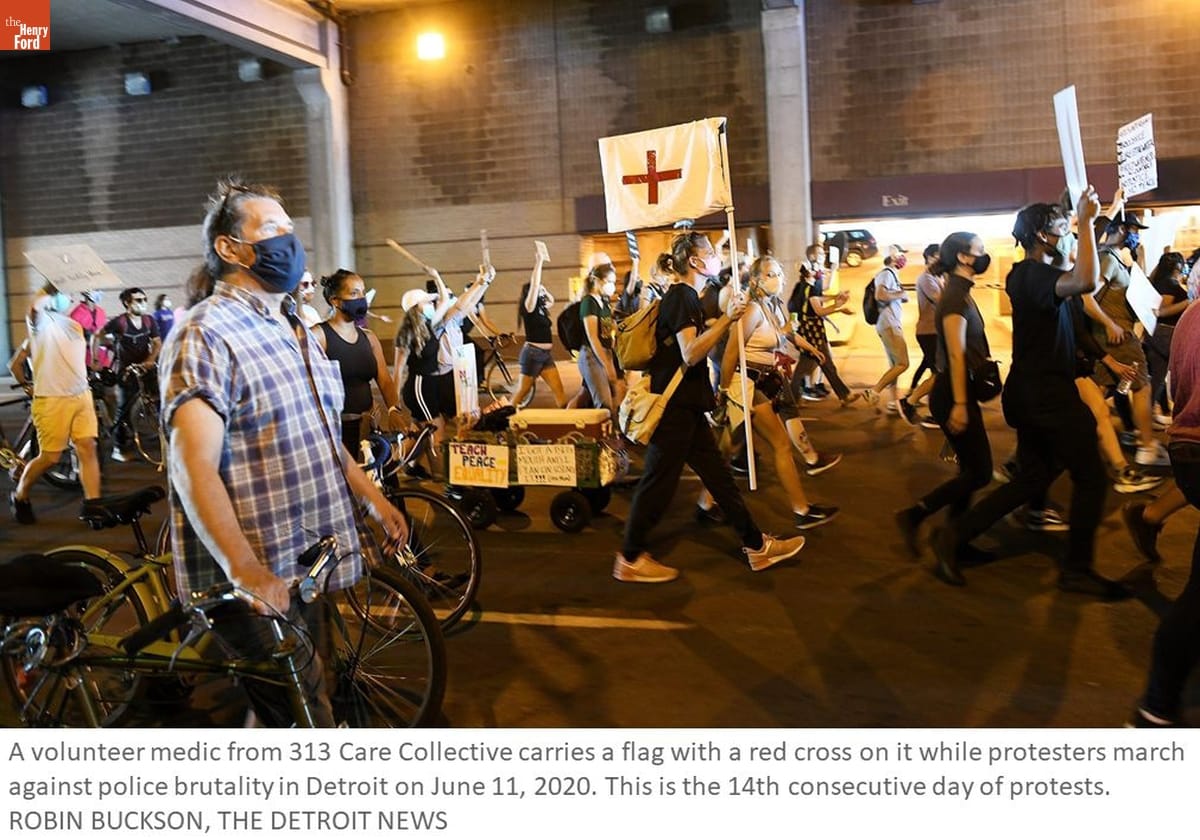
THF611162
Miley Kirby came out publicly and applied trans flag patches to her medic bag during Detroit’s Black Lives Matter protests, which held supplies used to provide medical care to fellow protestors. Kirby is visible carrying this same bag in the center of the press photo above, published in the Detroit News during the Black Lives Matter protests of Summer 2020.
“The people I met at the [George Floyd] protest were one of the first groups of people that encouraged me to be me. They refused to let me cop out on pronouns, names, or hand-waving of my transness for others comfort. We yelled our message in the streets, why not scream your identity to the world? My time in those protests found me my voice as Miley Kirby, or at least the beginning of one.” – Miley Kirby 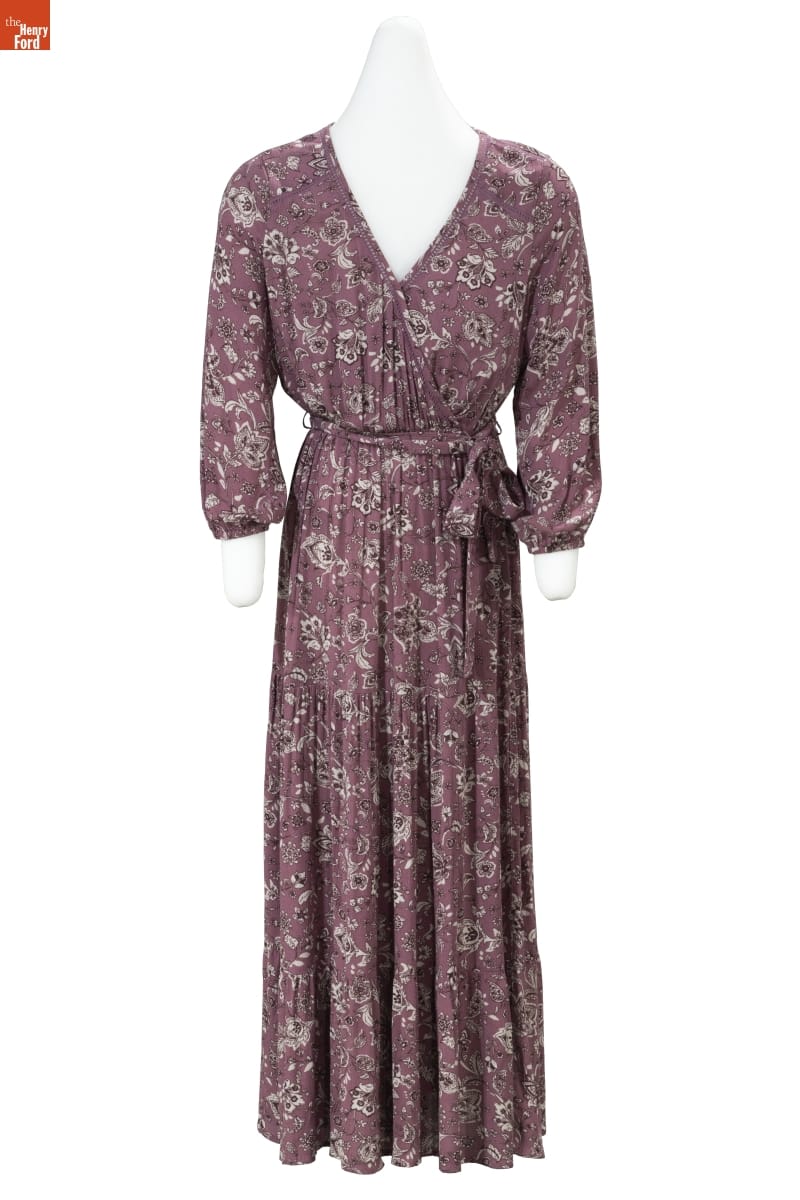
THF190458
Allie Zecivic listened to an insistent inner voice and purchased this dress, her first article of women’s clothing. It helped her to accept her gender identity as a transwoman.
“Hot Topic skinny jeans and too tight graphic tees were alright, but this was a dress. A long, flowy, spinny dress. I spent a lot of time sitting alone in my room wearing it, my heart racing and the paranoia spinning horrible outcomes in my head, but it felt right. The validation that dress brought was freeing. It was this feeling in the face of trepidation of being caught, that solidified my need for more. And such my wardrobe grew.” – Allie Zecivic 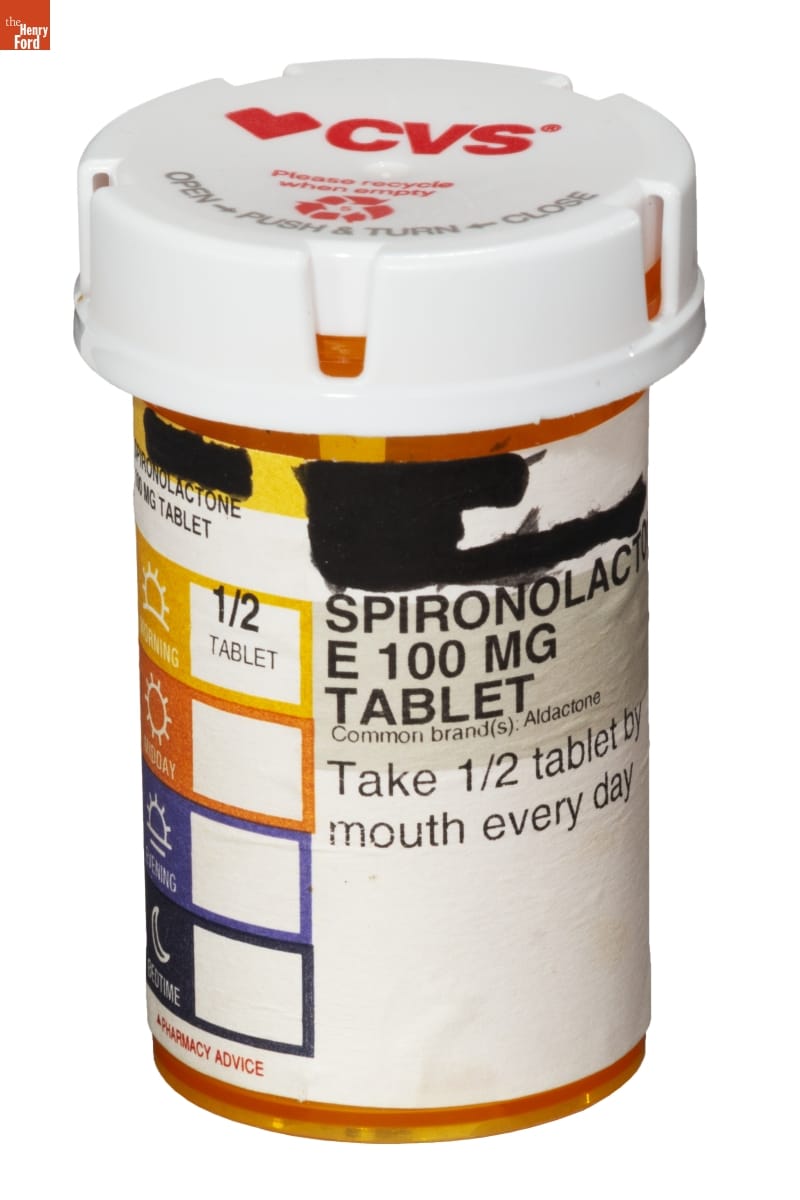
THF190456
THF190457
Laura Bowman began the medical transition to female with these hormone replacement therapy medications. She crossed out her “deadname”—the male name she was given at birth—and kept these bottles as symbols of her journey.
“Hormones don't make a transperson trans, but for many of us they are the beginning of the end. The end of the old life, and the beginning of a new experience, a new chance to be who we want to be, to make the outside fit how we feel inside. When I first picked up these pill bottles, I felt a giant weight off my chest as it felt like I was going to be able to make some progress on that person in the mirror and come to like her just a little better. The major part of that comes when you change the way you perceive yourself, but damn do the hormones help!” –Laura Bowman
Body Positive
Carrie Metz-Caporusso is an artist and tattooer who identifies as queer and non-binary. They began tattooing in 2011 and are committed to challenging traditions in tattooing culture that sometimes stigmatize LGBTQ+ and larger-bodied people. After experiencing fat shaming in the tattooing world, Carrie brainstormed a way to celebrate—rather than conceal—plus-sized body types with custom “roll flower” tattoos. These tattoos align with the body positivity movement by embracing the natural folds and creases on client’s backs or sides, which serve as a “stem” for flowers and leaves emerging from above and below.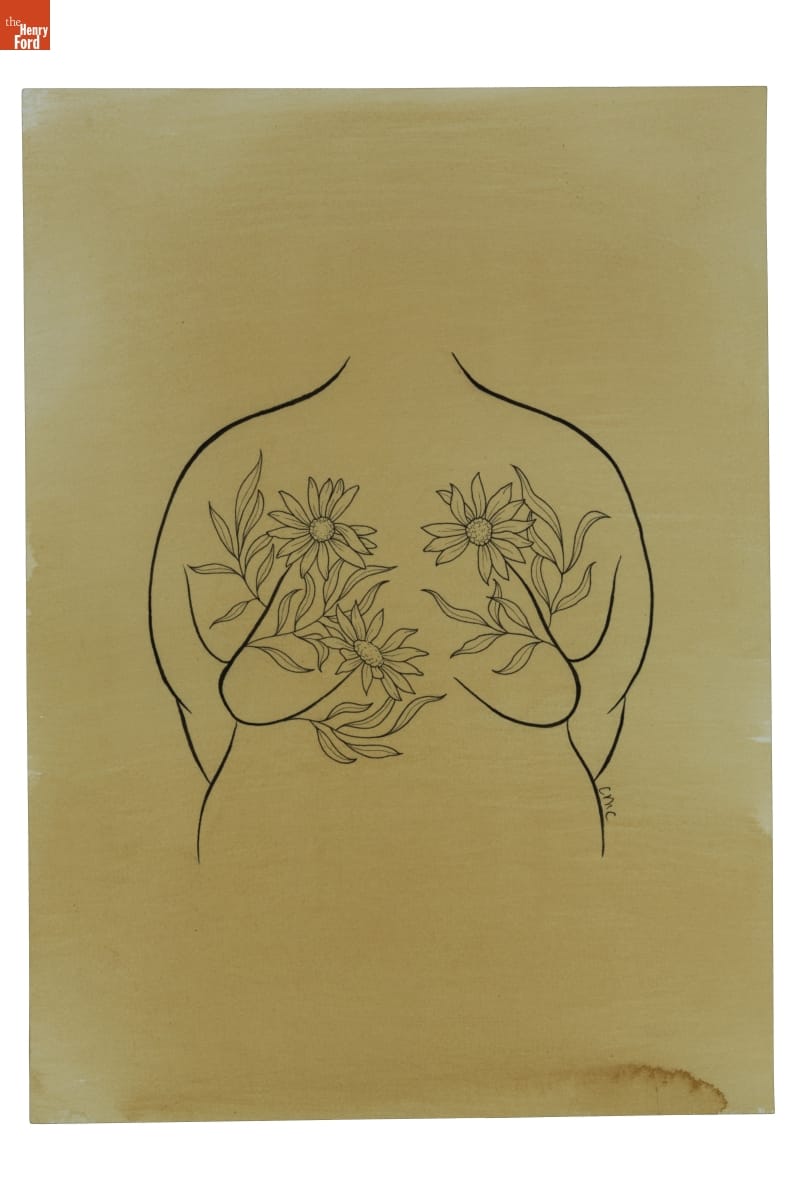
THF190488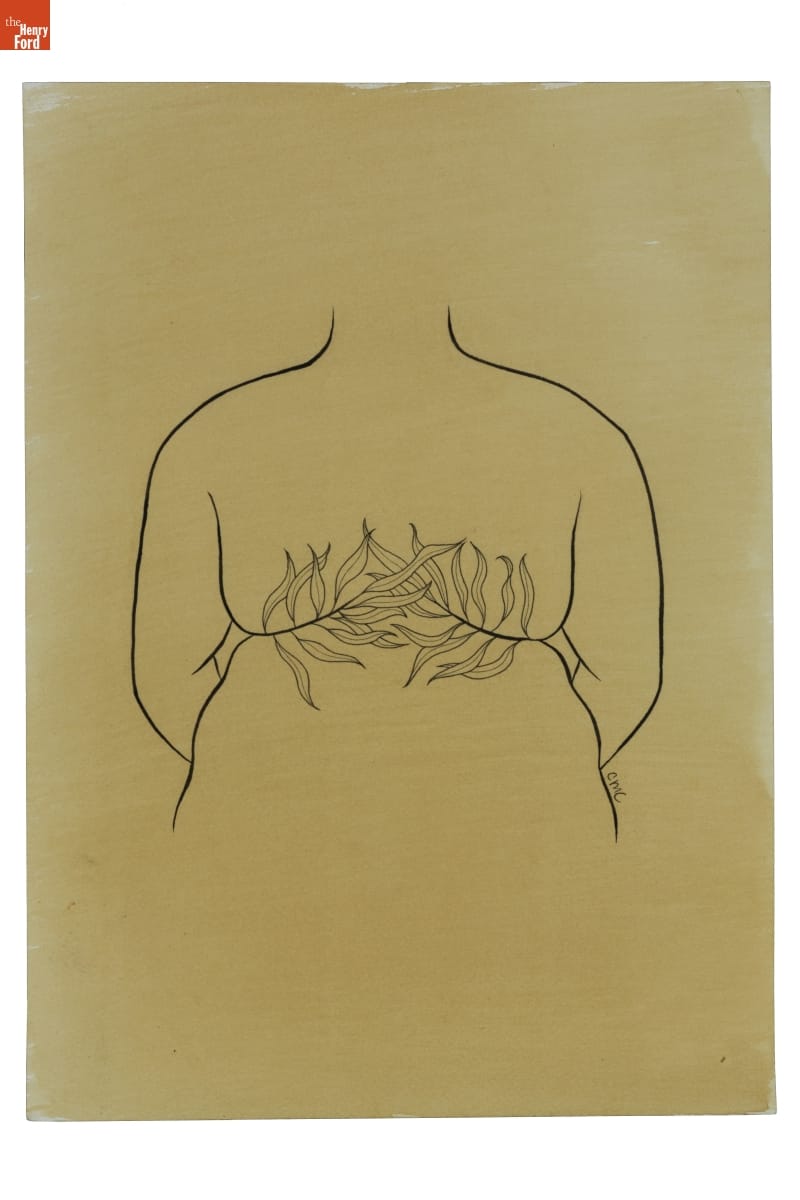
THF190489
These signature “roll flower” tattoo flash designs were drawn and donated by Metz-Caporusso to The Henry Ford. In 2022, The Henry Ford commissioned Metz-Caporusso to create illustrations for apparel, which will soon be available in museum stores. 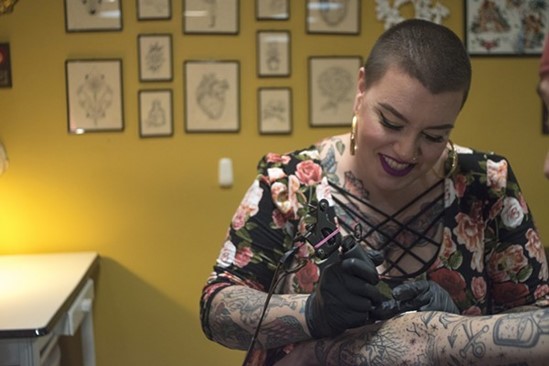
Photo courtesy of Carrie Metz-Caporusso
Mother of the Movement
Marsha “Pay It No Mind” Johnson was a New York City–based drag performer and activist who identified as a gay transvestite (the term transgender was not used at that time).
She was tireless in her advocacy for gay rights. From the mid-1960s on, she was an active presence—often a mischievous instigator—at almost every major uprising, parade, and political action connected to the LGBTQ+ equality movement. She clashed with police during the Stonewall Uprising, helped create the Gay Liberation Front, and participated in AIDS awareness group ACT-UP. With Sylvia Rivera, Johnson was a “house mother” for the Street Transvestite Action Revolutionaries—a political collective and homeless shelter for trans youth of color. Johnson died under suspicious circumstances in 1992—believed by many to be a victim of anti-gay violence.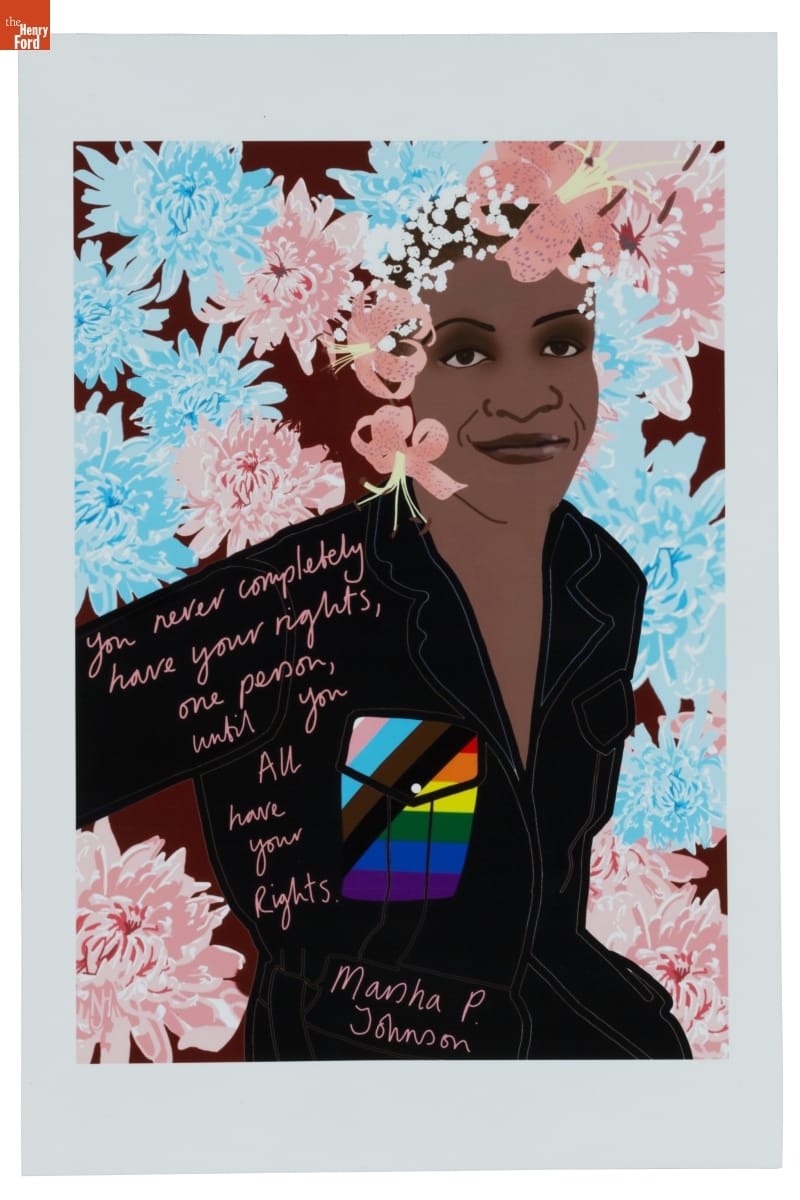
THF190491
This print, created by Julia Feliz in 2018, honors the intersectional legacies of Black LGBTQ+ leaders, as well as Daniel Quasar’s redesign of the Pride Flag to include stripes for BIPOC (Black, Indigenous, and people of color) and trans people.
Listening to the Community
The stories and lives represented in this exhibit just barely scratch the surface of what it means to be LGBTQ+ in the United States. Visibility often increases vulnerability—and backlash. Bigotry, discrimination, and social justice issues related to equal rights and access continue to impact LGBTQ+ people around the world.
Kristen Gallerneaux, Curator of Communications & Information Technology at The Henry Ford, and Katherine White, Associate Curator at The Henry Ford, collaboratively produced this exhibit and blog.
Henry Ford Museum, by Katherine White, by Kristen Gallerneaux
 Soybean Harvesting / Photo courtesy of the United Soybean Board
Soybean Harvesting / Photo courtesy of the United Soybean Board
Farmers have only a narrow window of opportunity to harvest their crops. For Michigan soybean growers, that window generally runs from the end of September through November, but is impacted yearly by weather events. By that point in the season, the plant is fully mature and has lost most of its leaves, and only the stalk and pods (with three to four beans per pod) stand in the field (R8 Growth Stage). The seeds are brown and hard at this point, and bean moisture content is 13-15%.
A Close-Up of the Modern Soybean Harvesting Process / Photo courtesy of the United Soybean Board
Harvesting soybeans—to cut the stalk, separate the bean from the pod, clean the bean, and store it until moved from harvester to wagon or truck—requires a multifunctional machine. Soybean growers benefitted from around a century of experimentation with specialized harvest machines when it came time for them to look for the best machine for the job. Farmers need machines that work, and different machines to harvest different crops. The Henry Ford has some of the earliest of these mechanical innovations, each suited to a specific crop—the Ambler mowing machine for hay, models of the Hussey and McCormick reapers for grains, and the Manny combined mower and reaper (one machine adaptable for both crops).
These early-19th-century innovations represented solutions to the problem of how to reduce human labor costs. Farm families often could not meet labor demand during harvest seasons. Too little labor meant lost crops, and lost crops made it difficult for farmers to feed their livestock (hay) or earn income from market crops (grain). Hiring labor was expensive, and even more expensive during peak demand at harvest time.
A century passed between the 1830s, when mechanical reapers and mowing machines first became viable, and the 1930s, when the first Allis-Chalmers All-Crop Harvester entered Michigan soybean fields.
Man Driving an Allis-Chalmers Tractor Pulling an Allis-Chalmers All-Crop Harvester at Michigan and Southfield Roads, Dearborn, Michigan, October 1936 / THF286727
The Crop
Michigan growers raised different types of beans during the early 20th century. Some raised bush beans (Phaseolus vulgaris), green beans that they harvested by hand when the pod reached the R5 growth stage and seeds had just begun to develop. Wholesale dealers distributed this perishable commodity to grocery stores while processors turned the bush beans into canned green beans. Others raised large fields of beans on contract with the H.J. Heinz Co. After the beans were fully matured and dry, growers harvested the crop by hand, then hauled the crop to a threshing machine that separated the beans from the pods and stems. Employees at Heinz processing plants continued the handwork, sorting beans from debris. Product advertising emphasized this attention to detail that yielded a quality food product.
A different type of bean—the “soy bean” (or soybean, Glycine max)—became increasingly apparent in southeast Michigan during the 1930s. Interest in this new cash crop grew apace with Henry Ford’s investment in soybean research. Scientists at work in the chemical laboratory that Ford built in Greenfield Village confirmed that soybeans had potential as a domestic source for various industrial products. Industrial demand in the region caused growers to seek a harvester suitable to the task.
Soybean Pods Ready for Harvesting / Photo courtesy of the United Soybean Board
Some farmers raised seed crops to meet growing demand for the new cash crop. This specialized cultivation required careful harvesting, as described in “Soy Bean Seed Production in Michigan” (1936). Others raised crops to meet the growing demand for the new industrial raw material. The Ford Village Industries complex in Saline, Michigan, opened in 1938. A press release issued by Ford Motor Company in July 1938 indicated that 700 farmers planted 22,588 acres of soybeans processed at the Saline facility. Ford processing capacity increased as the soybean processing plant at the Rouge Plant began operations around 1942.
Ready for the Harvest: The Allis-Chambers All-Crop
Farmers needed mechanical harvesters to ensure that they delivered a prime crop to Ford Motor Company. Henry Ford thus took an interest in this technology. Allis-Chalmers released its All-Crop 60 harvester in 1935, designed to operate off a tractor big enough to pull a double-bottom plow and powered by the tractor’s power take-off. The “60” represented the width in inches of the swath cut by the harvester. Ford tested the capability of the Allis-Chalmers All-Crop Harvester on a Ford Farms soybean crop in October 1936. By that time, Allis-Chalmers had sold 8,200 of the machines.
The engineer who took a leading role in the machine’s development was Charles J. Scranton, Jr. He began his career as a draftsman at Avery Company, a Peoria, Illinois, company noted for steam traction engines, threshers, and other farm equipment that went bankrupt in 1923. Scranton, as an assignee to a successor company, the Avery Power Machinery Co., secured several patents for improvements to threshers during the late 1920s.
Scranton joined Allis-Chalmers by working at the LaPorte, Indiana, location by 1934. Over 30 years, he secured around 40 patents, all focused on harvesting machinery. The All-Crop marked a crowning achievement because it suited the needs of farmers operating on a smaller scale and growing different cash crops, including soybeans, clover, milo, and other grains.
Ford featured the Allis-Chalmers All-Crop Harvester in early promotional photographs of the Ford tractor with the “Ferguson System,” the Ford-Ferguson 9N, released in 1939. This marked a ringing endorsement from the industrialist who launched soybeans as a cash crop in Michigan.
A Ford-Ferguson Model 9N Tractor Pulling an Allis-Chalmers “All-Crop” Harvester, Macon, Michigan, November 1939 / THF701486
Rear view of the Allis-Chalmers “All-Crop” Harvester, pulled by a Ford-Ferguson Model 9N Tractor, Macon, Michigan, November 1939 / THF701489
More Crop in the Hopper
As soybean acreage increased across the Midwest after World War II, farm implement companies continued to innovate. The Allis-Chalmers All-Crop was well suited to smaller scale farmers growing a variety of crops, but the scale of production increased dramatically during the 1950s as farmers in the midwestern Corn Belt shifted toward monoculture, e.g., corn, a crop heavily dependent on nitrogen, and soybeans, a legume that helps retain nitrogen in the soil. Farmers saw this combination as a strategy to help reduce input costs for synthetic and nitrogen-rich fertilizers.
Illinois-based agricultural implement manufacturer Deere & Company gained an advantage in 1954 when the company introduced an attachment that farmers could install on their combine harvesters to harvest corn. They could harvest their bean crop by switching out that attachment with a four- or five-bat (or horizontal bar) reel mechanism that drew the bean crop into the cutting head. Interchangeable front-end attachments became an industry standard.
The New Holland TR70 Axial Flow Combine, 1975, with Corn Attachment, on Exhibit in Henry Ford Museum of American Innovation / THF57471
The New Holland TR70 Axial Flow combine in Henry Ford Museum of American Innovation is installed with the corn harvester attachment. Farmers could harvest four rows of corn in one pass through the field with this head. To harvest soybeans, they installed a different attachment to the front end, a “pickup reel,” as illustrated below in a New Holland TR70 product catalog. The promotional literature urged farmers to purchase a floating “cutterbar” and a “robot header height control” to harvest most efficiently.
Sperry Rand Corporation - Sperry New Holland Division Catalog, "TR70 Twin Rotor Combine," 1977, Page 10 Detail / THF298867
Soybean acreage increased rapidly from the late 1970s into the 1980s. This sustained research in and development of combines suitable to cutting, threshing, and cleaning soybean crops (along with corn and other smaller grains).
Ford New Holland Agricultural Equipment, 1985, Detail / THF277396
For additional information:
“Charles Scranton Dies; Was Engineer,” Indianapolis Star, 27 July 1980, pg. 14, sec. 3.
Swinford, Norm. Allis-Chalmers Farm Equipment, 1914-1985. American Society of Agricultural Engineers, 1994.
U.S. Patent and Trademark Office records include more than 40 patents secured by Scranton during his work with Allis-Chalmers and at least three from his years with Avery Company.
Debra A. Reid is Curator of Agriculture and the Environment at The Henry Ford. This blog post was produced as part of our partnership with the Michigan Soybean Committee to deepen understanding of the important soybean crop and to provide the public with the chance to learn more about agriculture and the innovations that have helped farmers feed the world. You can learn more about the partnership, soybeans, and soybean ties to The Henry Ford in our kickoff post here.
Additional Readings:
- Agriculture and the Environment
- Getting Seeds in the Ground: Urgent Business
- A Horse-Drawn Recycler: The Manure Spreader
- Fordson Tractor, 1917-1918, Used by Luther Burbank
Henry Ford Museum, Michigan, by Debra A. Reid, farms and farming, farming equipment, agriculture, soybeans
Traveling by Ocean Liner: Dressing the Part

The summer 2022 installation of What We Wore: Traveling by Ocean Liner. / THF190376
The summer 2022 installation of the What We Wore exhibit in Henry Ford Museum of American Innovation featured garments worn by the Roddis family of Marshfield, Wisconsin, while traveling by ocean liner.
Postcard of Cunard’s White Star Line RMS Queen Mary, about 1949. / THF256419
During the mid-20th century, more Americans had the means and opportunity to experience a vacation abroad. Whether looking for relaxation or seeking adventure, these travelers enjoyed visiting places very different from home. Travel by ocean liner had become faster, more comfortable, and less expensive—and was part of the adventure.
Passenger list for Cunard White Star Line’s RMS Queen Mary, 1949. / THF701257
Traveling on an ocean liner in elegant first-class surroundings—a kind of five-star floating hotel—meant dressing up nearly every evening. So, into trunks and suitcases went formal dresses and tuxedos, along with daywear for shipboard activities and sightseeing on land. Enjoying the superb service and elegant atmosphere on shipboard—while dressing the part— was half the fun for travelers like the Roddis family of Marshfield, Wisconsin.
By the mid-1960s, most people would choose speedy airplane travel over grand ocean liners, and travel would become increasingly less formal.
Packing for ocean liner travel required careful planning. Nearly every evening, passengers donned formal dresses and tuxedos. Catherine Roddis took the evening dress below along on a 1948 cruise through the Caribbean to Brazil onboard the SS Nieuw Amsterdam.
Catherine Roddis (shown here with her daughter Augusta and husband Hamilton) wore the evening dress below in the Champlain Dining Room of the SS Nieuw Amsterdam, 1948. / Photo courtesy of the Estate of Augusta Denton Roddis
Evening Dress, about 1941, worn by Catherine Roddis. / THF166578
Augusta Roddis wore the dress shown below for daytime activities during a 1949 European trip onboard the RMS Queen Mary—the world’s fastest ocean liner in the late 1940s.
Day Dress, 1945. Worn by Augusta Roddis. / THF166561
Augusta Roddis, with her luncheon partner, in the first-class dining room of the RMS Queen Mary, September 1949. / Photo courtesy of the Estate of Augusta Denton Roddis
Catherine Roddis packed the dress shown below for a trip to Europe onboard RMS Queen Elizabeth. Margery Wilson, author of a 1941 etiquette book, recommended lace for travelers—it held its shape in any climate, required little ironing, and always looked elegant.
Dress, about 1948, worn by Catherine Roddis. / THF166563
Catherine Roddis (shown here with her son-in-law and daughter, Henry and Sara Jones, and husband Hamilton) wore the dress depicted above during a trip to Europe onboard the RMS Queen Elizabeth in 1950. / Photo courtesy of the Estate of Augusta Denton Roddis
While packing for ocean liner travel might be less complicated for male passengers like Hamilton Roddis, it still required suits and ties—and often a tuxedo.
Suit, 1951, worn by Hamilton Roddis. / THF165826
Hamilton Roddis and his daughter Augusta play shuffleboard on the SS Manhattan in 1938. / Photo courtesy of the Estate of Augusta Denton Roddis
Jeanine Head Miller is Curator of Domestic Life at The Henry Ford.
by Jeanine Head Miller, travel, fashion, Henry Ford Museum, What We Wore
On April 30, The Henry Ford was thrilled to welcome 150 student inventors from across the state to participate in the state finals of Invention Convention Michigan (ICM), the Michigan affiliate for Invention Convention Worldwide. The event marked the return of an in-person Invention Convention after two years of virtual programming.
Out of 1,290 young inventors who competed in regional STEM competitions across the state of Michigan, 150 were selected to participate in Invention Convention Michigan. / Photo by Purple Frog Photography
The atmosphere was electric as students in grades 3 through 12 presented their original inventions on the floor of Henry Ford Museum of American Innovation alongside some of the greatest innovations in American history. The young inventors were buzzing with nervous energy when it came time for judging, but once the pressure was off, they felt a rush of accomplishment and were free to explore the museum, garnering more inspirational energy for the year ahead.

Students pitch their inventions to volunteer judges and share their process, from identifying a problem to developing a solution and designing a prototype. / Photos by Purple Frog Photography
During their lunch break, students were given the opportunity to participate in the Innovation Passport Zone. Traveling from booth to booth around the plaza, inventors learned about some of ICM’s sponsors—including Hagerty, Michigan Soybean Committee, and presenting sponsor Delta Dental of Michigan—and got their “passports stamped” for a chance to win a hefty grand prize of donations offered by the sponsors.


Students interact with representatives from Delta Dental of Michigan, Hagerty, and Michigan Soybean Committee in the Innovation Passport Zone. / Photos by Purple Frog Photography
After the scores had been tabulated, students gathered under the DC3 for the awards ceremony, which began with a special word from the president of The Henry Ford, Patricia Mooradian, and a keynote address by Kwane Watson, inventor of the mobile dental unit.

Students enjoyed interacting with Dazzle, mascot for Delta Dental of Michigan, and The Henry Ford’s own Mike Moseley served as emcee for the event. / Photos by Purple Frog Photography
In all, over $3,500 in cash prizes was awarded to 21 of Michigan’s student inventors. Of these, 13 students were selected to advance to the Raytheon Technologies Invention Convention U.S. Nationals taking place at The Henry Ford June 1-3. To watch a replay of the awards ceremony, click here.
Congratulations to these 21 student inventors, who were recognized with awards during the awards ceremony. / Photo by Purple Frog Photography
A special congratulations goes out to Meera R., who was the Grand Prize Winner, presented by Delta Dental of Michigan, as well as the winner of the Make the World Award, presented by Stanley Black & Decker; the Originality Award, presented by Hagerty; and the Safety Award, presented by Hitachi Astemo. Meera will also be among the 13 inventors selected to represent Michigan at U.S. Nationals in June. / Photo by Purple Frog Photography
It was wonderful to see the museum plaza filled with passionate and joyous students, along with proud families and educators. We look forward to experiencing the thrill of Invention Convention U.S. Nationals in a few weeks and want to congratulate all of our student inventors once again for all of their hard work.
Katie Dallos is Program Coordinator, Invention Convention Michigan, at The Henry Ford and Samantha Rhoads is inHub Marketing Specialist at The Henry Ford.
Michigan, events, Henry Ford Museum, philanthropy, by Katie Dallos, by Samantha Johnson, education, inventors, childhood, innovation learning, Invention Convention Worldwide
 Versatile #276 Tractor Pulling a Deere Low-Till Planter, 1989 / THF277397
Versatile #276 Tractor Pulling a Deere Low-Till Planter, 1989 / THF277397
Henry Ford Museum of American Innovation includes an exhibition called Agriculture and the Environment. The first section, Preparing the Soil, includes artifacts used by farmers to prepare the seed bed and plant crops. These artifacts all reflect practices common during the mid-19th to early-20th centuries, with the exception of two items: one, a Caterpillar continuous track tractor designed for use in orchards, and the John Deere 7000 No-Till Planter, also known as the MaxEmerge 7000 conservation planter. This post puts the Deere MaxEmerge planter into perspective and explains its utility as a no-till planter, both historically and today.
Tillage
A quick overview of tillage—that is, how farmers prepare land for growing crops—helps lay the groundwork (as it were). For thousands of years, farmers turned the topsoil over with a plow pulled by a draft animal—a single steer or team of oxen, draft horses, or mules. Henry Ford’s experiments with his “automotive plow” and subsequent introduction of the affordable Fordson tractor led to the replacement of draft animals on most farms after World War II, but the plow endured. Plowing broke up the roots of whatever vegetation was established before or between plantings. This was the first step in preparing a seed bed.
Man Using a 1939-1946 John Deere Model "B" Series Tractor / THF286596
The next step involved working the plowed ground to break up clods and create a more even surface. This required use of harrows or discs of various designs, as you can see here. Hitching technology installed on the Ford-Ferguson 9N tractor starting in 1939 and adopted by tractor manufacturers helped keep this disc tracking in line with the tractor. Farmers with large acreages under tillage favored row-crop tractors like the John Deere Model “B” in the photo below, where a farmer is discing a plowed field. The narrow wheel-spacing at the front end ran between rows of crops. After plowing and discing, some farmers harrowed fields to put the finishing touches on the seedbed.
Man Using a 1947-1952 John Deere Model "B" Series Tractor / THF286606
You can explore more than 40 tillage implements in The Henry Ford collection here. This is just the tip of the iceberg of mechanical innovations designed to ease the physically demanding process of field preparation. These tools helped farmers practice integrated pest management, too, because careful field preparation pulverized the organic material that insects like boll weevil in cotton or corn borer larvae lived in during the winter months. These pests could destroy crops in a pre-insecticide agricultural system.
Tillage, however, exposed topsoil to the elements. The more acreage farmers tilled, the more topsoil they lost due to erosion. In addition, severe droughts parched soil, destroying all organic matter. This exacerbated erosion as more and more topsoil blew away or washed away with heavy rains.
Planting and Cultivating
Different crops cover the ground in different ways. Farmers raising small grains drilled seed into prepared seed beds. The grain, planted at times of the year when other plant growth slowed, needed little to no cultivation. You can see grain drills and learn more about them here, including photographs of the Bickford & Huffman grain drill in use at Firestone Farm in Greenfield Village.
Prior to the adoption of in-season herbicides, most crops required cultivation after planting to disturb the roots of plants that threatened to choke out the cash crop. Farmers used different cultivators depending on the crops they grew, but cultivators further disturbed the soil and could hasten moisture evaporation.
Cultivating a Field of Cotton, Around 1911 / THF624655
The photograph below shows a row-crop tractor with an under-mounted cultivator at work in a soybean field. The single-front tire running down the middle of two rows ensured that the cultivators tracked between rows, to better remove weeds in between the cash crop.
Man Using a 1935-1938 John Deere Model "B" Series Tractor / THF286604
The Development of No-Till
You may have already grasped the connection between tillage and the no-till planter. Intensive cultivation of cropland contributed to topsoil erosion. The loss of the fertile topsoil reduced yields, and extreme weather worsened the loss. This led many to call for radical changes in tillage methods.
Agricultural scientists and engineers with the U.S. Department of Agriculture and state-based land-grant colleges addressed the challenge quickly. The University of Illinois established the Dixon Springs Agricultural Center in southern Illinois in 1934 to research soil erosion and low-till options. Purdue University in Indiana began the first experiments planting row crops in uncultivated soil in 1944. Russell R. Poyner, the agricultural engineer who worked on this project, went to work at International Harvester Company in 1945. By 1947, he submitted a patent for a mulch-tiller-planter designed for erosion control and conservation of moisture. He coined the new tillage approach “stubble mulch” farming, and as assignor to International Harvester, received U.S. Patent No. 2,577,363 in 1951. International Harvester produced the two-row McCormick M-21 till planter with fertilizer application only briefly and stopped altogether in 1955 due to sluggish sales.
Another early no-till proponent, agronomist George McKibben, worked at Dixon Springs. He and Donnie Morris, the machinery engineer at Dixon Springs, tested a zero-till planter by 1966. Morris describes the challenges he solved—specifically, how to get the seed in the ground. The research team used his “sod and stubble” planter starting in 1969, but an appeal to Deere and Company (the company that makes John Deere brand items) fell on deaf ears.
Allis-Chalmers released the two-row No-Til planting system in 1966, recognized as the first commercially available (and successful) no-till planter. The planter had a fluted coulter (vertical cutting blade) that sliced crop residue and prepared the seed bed just ahead of the fertilizer tank and planter unit.
The John Deere 7000 No-Till Planter: Agricultural Superstar

John Deere 7000 No-Till Planter, 1978 / THF151661
Peter Cousins, then Curator of Agriculture at The Henry Ford, acquired the John Deere 7000 No-Till Planter because, as he wrote in a memo to The Henry Ford’s collections committee on August 23, 1994, he considered it one of a few “superstars” of modern agricultural technology. In that same memo, he explained that of the three companies that introduced no-till planters, only Deere and Company survived. Allis-Chalmers left the farm implement business in 1985. International Harvester also ended its agricultural lines and broke up in 1985. Thus, he believed that only Deere and Company could locate, restore, and donate a first model no-till planter.
What qualifies as a “superstar?” Peter does not go into detail, but he names one other artifact in his memo—the FMC tomato harvester (1969). These two artifacts share at least three key elements that Peter considered as he strengthened The Henry Ford’s collection of 20th-century agricultural technology. First, the implement represents exchange between adopters, engineers, and others, a process described as the social construction of technology. Second, the implement transforms agricultural production. Third, the consequences of the transformation reverberate beyond farm fields.
A Modern John Deere No-Till Planter Sowing Soybeans / Photo courtesy of the United Soybean Board
The collaborative research undertaken by teams of experts at agricultural experiment stations across the country satisfy the first of these three “superstar” criteria. The experiments station staff worked with farmers to determine their needs and respond to them. The planter donated by Deere and Company to The Henry Ford, for example, had been used by Arthur Kruse on his Calmar, Iowa, farm between 1979 and 1994. It included “a wheel module planter with dry fertilizer option, insecticide box, unit mounted coulters, and cast closing wheels.” That insecticide box is telling—the stubble-mulch farming system came with another set of challenges. The stubble served as a vector for pests, namely the European corn borer in corn. A no-till planter that applied insecticide as well as dry fertilizer appealed to farmers even more.
Soybean Seedlings Emerging Among the Residue of the Previous Year’s Crop / Photo courtesy of the United Soybean Board
No-till planter technology changed the system of agriculture. The title of a July 16, 1994, New York Times article that Peter attached to the collections committee memo says it all: “New Way of Tilling Speeds the Plow’s Demise.” Today, no-till or conservation tillage helps farmers reduce erosion and retain soil moisture. Yet, input costs remain high as they apply herbicide to deaden growth before no-till planting, and then apply fertilizer and insecticides while planting.
On the other hand, Michigan State University researchers claim that “no-till farming practices have very positive economic and environmental benefits over decades.” Farm fields can benefit from the environmental benefits of topsoil retention enriched with hygroscopic (tending to absorb moisture from the air) organic matter. They can also realize higher yields over the long run.
Farmers, Please Share Your Stories
The Henry Ford would love to hear from Michigan farmers about your reasons for adopting no-till farming practices, either wholly or selectively, and what you believe the benefits are. You can e-mail us your feedback at MichiganSoybeanFarmers@thehenryford.org.
Debra A. Reid is Curator of Agriculture and the Environment at The Henry Ford. This blog post was produced as part of our partnership with the Michigan Soybean Committee to deepen understanding of the important soybean crop and to provide the public with the chance to learn more about agriculture and the innovations that have helped farmers feed the world. You can learn more about the partnership, soybeans, and soybean ties to The Henry Ford in our kickoff post here.
Additional Readings:
- Massey-Harris Model 20 Self-Propelled Combine, 1938
- Horse Power
- Steam-Powered Agriculture
- Fordson Tractor, 1917-1918, Used by Luther Burbank
environmentalism, Henry Ford Museum, farms and farming, farming equipment, agriculture, by Debra A. Reid
Walt Disney Visits The Henry Ford
Walt Disney spent years imagining his ground-breaking entertainment venue, Disneyland, before it opened in 1955. Disney found inspiration for this remarkable theme park from many people and places.
Walt Disney (1901–1966) spent his most memorable childhood years in Marceline, Missouri, leaving him with a great fondness for small town America. Disney's early passion for cartoon drawing and humor blossomed in 1928 with his first major success, the Mickey Mouse animated cartoon character. By the 1930s, Disney headed a thriving motion picture studio making animated cartoons and live action movies. He explained his interest in developing a theme park to his biographer, Bob Thomas:
“It all started when my daughters were very young, and I took them to amusement parks on Sunday. I sat on a bench eating peanuts and looking around me. I said to myself, why can't there be a better place to take your children, where you can have fun together? Well, it took me about fifteen years to develop the idea.”
While on business trips and family vacations, Disney visited not only amusement parks, but also fairs, expositions, tourist attractions, and zoos to further his vision of creating an extraordinary family leisure experience. One of these places was Greenfield Village, which Walt Disney visited several times during the 1940s.
Walt Disney Posing in the Greenfield Village Tintype Studio, 1940 / THF109756
Walt Disney paid his first visit to Greenfield Village on April 12, 1940. William B. Stout, an industrial designer best known for the Ford Tri-Motor airplane and the aerodynamic Scarab car, served as Disney's escort as he toured Henry Ford's historical village and museum. The Greenfield Village Journal, a daily administrative report, described Disney’s visit that day:
“Walt Disney, creator of the world-famous movie character, Mickey Mouse, visited the Village and Museum today. He showed great interest in everything mechanical, examining engines and old autos closely. He had a good time with Mr. Tremear while posing for a tin-type. In the Museum Theater he spoke for a few moments to the school children. He was accompanied by Mrs. Disney, and by Ben Sharpsteen, his chief animator. Wm B. Stout was his host.”
Walt Disney Shows Harriet Bennett How to Draw Mickey Mouse during a Visit to Henry Ford Museum, April 12, 1940 / THF118884
During Disney's tour, he stopped at the Tintype Studio to pose for photographer Charles Tremear, autographing one of his tintypes for display there. Disney also spent a few minutes talking with students from the Greenfield Village Schools, who had gathered in the museum's theater to greet him. (Henry Ford established a school system in his museum and village complex several years before his historical enterprise was formally opened to the public in 1933.) Ford Motor Company photographer George Ebling—who was often asked to take personal photographs for Henry Ford—captured images of Disney's delightful visit with the students.
Walt Disney and Family Visiting Henry Ford Museum, August 1943 / THF130871, THF130883, THF119434
On August 20, 1943, Disney again visited Henry Ford Museum. He; his wife, Lillian; and their daughter, Diane, posed for photographs with examples of some of the historical modes of transportation displayed there. Disney’s joyful, childlike expression embodies the experience he hoped to create for families visiting what would come to be Disneyland.
Walt Disney came back to Greenfield Village five years later, on August 23, 1948. Disney and one of his animators, Ward Kimball—who shared Disney's longtime fascination with railroads—had traveled to Chicago to attend the Railroad Fair. They decided to take a side trip to Greenfield Village. During the visit to Greenfield Village, Disney once again made a stop at the Tintype Studio, where he and Kimball were photographed by tintypist Charles Tremear.
Walt Disney and Ward Kimball Posing in the Greenfield Village Tintype Studio, 1948 / THF109757
By the late 1940s, Disney's ideas for a themed entertainment park had progressed substantially. On the train ride back to California, he shared his ideas with Kimball, then summarized them in a memo dated August 31, 1948. An excerpt of this memo seems to echo aspects of Greenfield Village: “The Main Village, which includes the Railroad Station, is built around a village green or informal park … Around the park will be built the town. At one end will be the Railroad Station; at the other end, the Town Hall…”
When Disneyland opened in Anaheim, California, in 1955, it quickly captured the public’s imagination. In his innovative theme park, Walt Disney drew inspiration from his many interests and experiences to create an entirely new kind of family entertainment. To learn more, check out this blog post!
This post by Cynthia Read Miller, former Curator of Photography and Prints at The Henry Ford, originally ran in September 2005 as part of our Pic of the Month series. It was reformatted for the blog by Saige Jedele, Associate Curator, Digital Content, at The Henry Ford.
photographs, popular culture, by Saige Jedele, by Cynthia Read Miller, Henry Ford Museum, Greenfield Village, Disney
Remembering Randy Mason (1941-2022)

Randy Mason (right) waves from inside the door of the Ingersoll-Rand Diesel-Electric Locomotive No. 90, January 1985. / THF271030, detail
The Henry Ford is saddened by the passing of Randy Mason on Saturday, March 19, 2022. Randy was Curator of Transportation at our institution for 20 years. He left a lasting mark on our mobility collections, and on our annual Old Car Festival and Motor Muster shows.
Randy was operating an automobile rustproofing franchise in Inkster, Michigan, when he crossed paths with Leslie Henry, then The Henry Ford’s Curator of Transportation. Les was so impressed with Randy’s knowledge of automotive history, and his passion for the subject, that he convinced Randy to leave the franchise and put the full range of his talents to work at the museum.
Randy succeeded Les Henry as Curator of Transportation in 1971. He oversaw the automotive, railroad, and aviation collections at a transformative time for The Henry Ford. Tightly-packed rows of cars and machines, long a fixture at automotive and industrial museums, were falling out of favor with visitors, who wanted more in the way of explanation and context. Randy helped create uniform labels and signs, and more thoughtful displays, throughout The Henry Ford’s transportation exhibits.
Undoubtedly, the most dramatic change during Randy’s tenure came in 1987 with the opening of The Automobile in American Life. The 50,000-square foot exhibition was a landmark in interpreting automotive history. Rather than focusing on the car as a technology, the exhibit explored the many changes that the car brought to everyday life in the United States. Automobiles were shown alongside related objects, like highway travel guides, fast food restaurant signs, and even a real tourist cabin and a re-created Holiday Inn room, that provided greater context for guests. The Automobile in American Life was replaced by Driving America in 2012, but its core concept—treating the car not only as a technological force but as a social force—endures in the new exhibit.
Even after he left The Henry Ford, Randy remained active in the automotive world, both as a historian and as an enthusiast. He was involved with the Henry Ford Heritage Association and he worked on the successful effort to preserve the Ford Piquette Avenue Plant in Detroit. We will miss Randy, but we take heart knowing that his efforts, his knowledge, and his passion survive—in the artifacts he preserved, in the articles he wrote, and in the many new enthusiasts he inspired through his work.
Matt Anderson is Curator of Transportation at The Henry Ford.
20th century, 1980s, 1970s, Michigan, Dearborn, The Henry Ford staff, railroads, in memoriam, Henry Ford Museum, cars, by Matt Anderson, airplanes, #Behind The Scenes @ The Henry Ford
Barney Oldfield: America’s Racer
"You know me, Barney Oldfield" was the classic catchphrase of one of America's earliest celebrity sports figures. Indeed, during the nascent period of the automobile, most every American knew Berna “Bernie” Eli Oldfield (1878–1946). He became the best-known race car driver at a time when the motor buggy was catching the imagination and passion of a rapidly changing society. Oldfield cut a populist swath across turn-of-the century American society and, in the process, helped define an emerging cult of celebrity.
Bicycle Beginnings

Barney Oldfield Riding the "Blue Streak" Bicycle on the Salt Palace Board Track, Salt Lake City, Utah, circa 1900 / THF111772
One of the consistent themes of Oldfield's early years was a restlessness and desire for bigger, brighter, and better things in life. As a teenager, Oldfield worked odd jobs in Toledo, Ohio, earning money to buy his own bicycle to ride in local and regional road and endurance races. An attempt at professional boxing ended after Oldfield contracted typhoid fever. He returned to racing bicycles for company-sponsored teams and sold parts in the off-season. Throughout the 1890s, Oldfield was part of a team of riders that barnstormed across the Midwest, racing in the new "wood bowl" tracks that were sprouting up across the region. Oldfield quickly realized the need to appeal to audiences beyond the track. He branded himself the "Bicycle Racing Champion of Ohio" and promoted a "keen formula for winning," wearing a bottle of bourbon around his neck during races but telling reporters the liquid inside was vinegar.
Shift to Auto Racing

Tom Cooper and Barney Oldfield Seated in Race Cars, circa 1902 / THF207346
Americans were fascinated with quirky and expensive motor buggies. These boxy, carriage-like vehicles appealed to Americans’ desire for new, loud, audacious, and fast entertainment. During the winter of 1899, Oldfield reconnected with an old bicycle racing companion, Tom Cooper, who had just returned from England with a motorized two-wheeler (an early motorcycle). Cooper was going to demonstrate the vehicle at a race in Grosse Pointe, Michigan, near Detroit, in October 1901. He asked Oldfield, who began riding motorcycles himself around this time, to come along. Cooper and Oldfield were a preliminary exhibition before the main event: a race between local "chauffeur" Henry Ford and the most well-known and successful automobile manufacturer of the day, Alexander Winton.
After the Grosse Pointe event, Oldfield and Cooper pursued gold mining in Colorado. When that ended in failure, Cooper headed to Detroit to focus on automobiles. Oldfield took the motorized cycle on a circuit of Western bicycle tracks, setting records along the way before returning to Detroit in the fall of 1902 at Cooper’s request. Cooper had purchased Henry Ford’s “999” race car and wanted Oldfield to drive it. "The Race" between the “999” and Alexander Winton's "Bullet" captured the imaginations of not only Detroit's automotive elite, but the general population as well. When Oldfield piloted the “999” to victory over Winton's sputtering “Bullet,” the news spread like wildfire across Detroit, the Midwest, and eventually the nation.
Beyond the immediate thrill of the race itself, Barney Oldfield, the "everyman" bicycle racer from the heartland, appealed to a wide segment of American society rushing to embrace the motor car. As the Detroit News-Tribune reported after the race, "The auto replaced the horse on the track and in the carriage shed. Society sanctioned yesterday's races. And not only society, but the general public, turned out until more than five thousand persons had passed the gatekeepers.” Barney Oldfield became the face of racing for the "general public" and helped to democratize not only racing entertainment, but also automobiles in general, as vehicles moved out of the carriage house and into backyard sheds.
Barney Oldfield Driving the Ford "999" Race Car, circa 1903 / THF140144
Celebrity Status
Over the next 15 years, Barney Oldfield established multiple world speed records and gained notoriety wherever he went. He added an iconic unlit cigar to his racing persona and perfected the roguish image of a daredevil everyman. After a brief stint driving for Winton, Oldfield took the wheel of a Peerless racer, the "Green Dragon," and established himself as America's premier driver.
Barney Oldfield Behind the Wheel of the Peerless "Green Dragon" Racecar, circa 1905 / THF228859
By 1904, Oldfield held world records in the 1-, 9-, 10-, 25-, and 50-mile speed categories. In 1907, Oldfield tried his hand at stage acting when he signed on to appear in a new musical, The Vanderbilt Cup. Over a 10-week run and a brief road tour, Oldfield “raced” his old friend Tom Cooper in stationary cars as backdrops whirled behind them and stagehands blew dirt into the front rows of the theater. The following year, Oldfield entered the open road race circuit and quickly added to his legend by sparking a feud with one of the emerging stars of the day, Ralph De Palma. In March 1910, Oldfield added the title "Speed King of the World" to his resume, driving the "Blitzen Benz" to an astonishing 131.7 miles per hour on Daytona Beach in Florida.
Barney Oldfield Driving the "Blitzen Benz" Car on a Racetrack, 1910 / THF228871
Oldfield flouted the conventions of his time, both on and off the track. He was notorious for his post-race celebrations, womanizing, and bar fights. Oldfield’s rebellious streak kept him under the scrutiny of the American Automobile Association (AAA) and, in 1910, he became the first true "outlaw" driver when he was suspended for an unsanctioned spectacle race against the heavyweight boxing champion Jack Johnson. Undaunted, Oldfield and his manager set up dates at county and state fairs across the country, holding three-heat matches against a traveling stable of paid drivers. Oldfield padded his reputation by adding an element of drama to these events—he would lose the first match, barely win the second, and, after theatrically tweaking and cajoling his engine, win the third match. During this time, Oldfield also became a product spokesman (perhaps most notably for Firestone tires) and began racing a fellow showman, aerial barnstormer Lincoln Beachey, in matches pitting “the Dare Devil of the Earth vs. the Demon of the Skies for the Championship of the Universe!”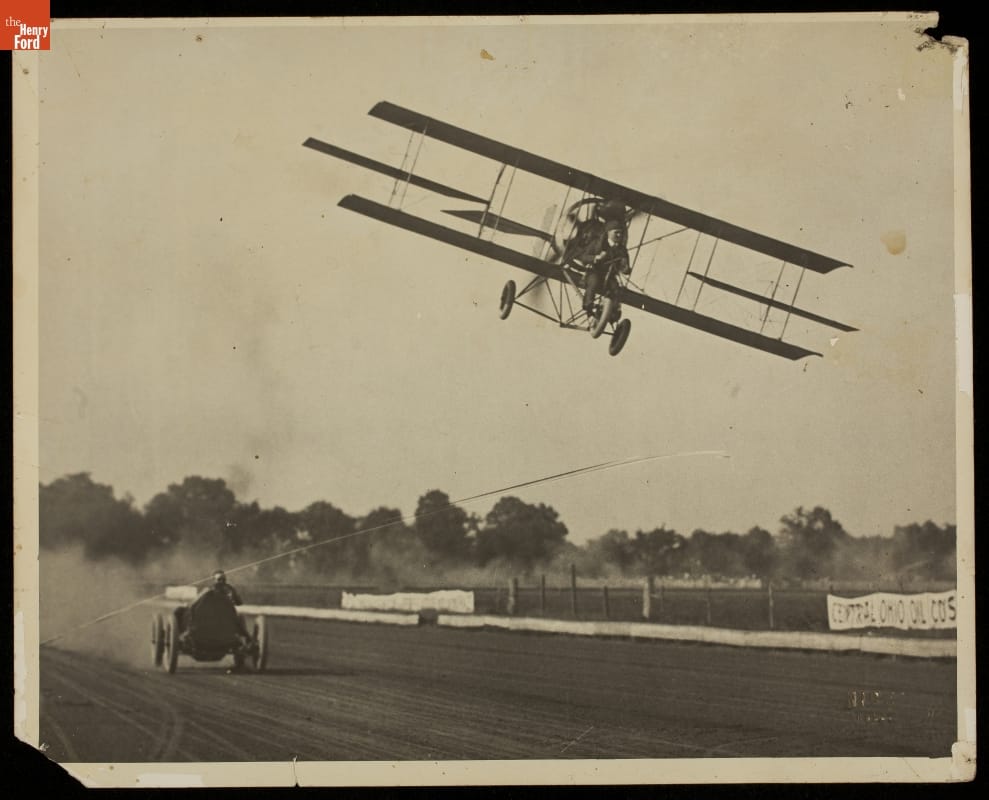
Barney Oldfield and Lincoln Beachey Racing, Columbus, Ohio, 1914 / THF228829
Towards the end of his driving career, Oldfield made a final splash in the racing world with the Harry Miller-built "Golden Submarine," establishing dirt-track records from one to one hundred miles. Throughout the 1917 season, Oldfield drove the Golden Sub in a series of matches on dirt and wood tracks against his old rival Ralph De Palma, eventually winning four out of the seven races. Oldfield retired from competition racing in 1918 after winning two matches in Independence, Missouri. In typical Oldfield fashion, he ran the last race under AAA suspension for participating in an earlier unsanctioned event.
Barney Oldfield Driving "Golden Submarine" Race Car at Sheepshead Bay Board Track, Brooklyn, New York, 1917 / THF141856
Oldfield continued to keep himself at the fore of America's sports entertainment culture. In addition to ceremonial "referee" jobs at various races, he rubbed elbows with American movie, stage, and music stars and continued his rambunctious lifestyle. Between 1913 and 1945, Oldfield appeared in six movies (usually as himself) and also tried his hand as a road tester for Hudson Motor Company, salesman, bartender, club owner, and spokesman. Finally, in an attempt to raise funds to build another land-speed racer with Harry Miller, Oldfield staged a unique publicity and fundraising event. In 1933, outside Dallas, Texas, he drove an Allis-Chalmers farm tractor to a record 64.1 miles per hour.
Barney Oldfield Advertising Postcard for Plymouth Automobiles, circa 1935 / THF228879
Fittingly, Barney Oldfield's last public appearance was at the May 1946 Golden Jubilee of the Automobile Industry held in Detroit. Oldfield was fêted for his foundational role in what had become one of the largest industries in the nation. He shared the main speaker's table with automotive icons including Henry Ford, Ransom Olds, and Frank Duryea, and he accepted a “trophy of progress” for his role in automotive history. Barney Oldfield passed away in October 1946, having lived—in the words of one passionate fan—“such a life as men should know.”
For more, check out our archival collection on Barney Oldfield, browse artifacts related to him in our Digital Collections, or visit the “Showmanship” zone of the Driven to Win: Racing in America exhibition in Henry Ford Museum of American Innovation.
This post by Peter Kalinski, former Archivist at The Henry Ford, originally ran in 2014. It has been updated by Saige Jedele, Associate Curator, Digital Content, at The Henry Ford.
Additional Readings:
- Driven to Win: Racing in America
- Henry Ford's “Sweepstakes” Celebrates its 120th Anniversary
- 1956 Chrysler 300-B Stock Car
- 1965 Goldenrod Land Speed Race Car
Ohio, 20th century, 19th century, racing, race cars, race car drivers, Michigan, Henry Ford Museum, Driven to Win, Detroit, cars, by Saige Jedele, by Peter Kalinski, bicycles, archives
Trained for the Track: Positioning Racing’s Athletes for Success
 Jim Leo of PitFit Training / Photo by Walter Kuhn
Jim Leo of PitFit Training / Photo by Walter Kuhn
You’ve probably heard this one before, and maybe you’ve even wondered it yourself: Are race car drivers really athletes? After all, isn’t the car doing all of the work? And how much different can it be than driving down the interstate, if only a lot faster?
Anyone in the business of motorsports will answer unequivocally “yes” to the first question and a resounding “no” to the second. So, too, will just about anyone who has spent time driving a race car or go-kart at speed on a racetrack.
Jim Leo, the founder and owner of PitFit Training in Indianapolis, is one of those who wholeheartedly endorses the fact that race car drivers are indeed athletes; however, his arrival at that answer came in a very methodical and hands-on way.
Leo has a degree in exercise physiology and biomechanics and early in his postgraduate career set up a health and wellness program for the employees of Detroit Diesel (now Detroit) in the early 1990s. At the time, the majority shareholder and CEO of Detroit Diesel was one Roger Penske of Penske Racing fame and an 18-time winner of the Indianapolis 500 as a team owner. At the time, Leo was not involved with motorsports and had only a passing interest in them when he approached Penske about creating a fitness regimen for his race teams—specifically, the pit crew members.
Soon after, PitFit Training was born, and Leo found himself training not only the Penske Racing crew members but crew members from other teams as well. This coincided with an increased emphasis on athletes across nearly every sport training more scientifically and specifically for the demands of their particular sport. It wasn’t long after that that drivers were coming to Leo for advanced fitness training.
Driver James Hinchcliffe (left) training. At PitFit, it’s common practice for physical exercise to be immediately followed by mental acuity challenges. / Photo by Walter Kuhn
Pilot Parallels
Now, after more than 20 years in the sector, Leo has honed and refined the techniques he uses to keep drivers physically and mentally performing at their peak. “There’s no question that race car drivers are athletes,” said Leo. “But I’ll take it one step further and say that they are more akin to fighter pilots.”
“If you look at a driver’s physical requirements, such as the elevated heart and breath rates, enduring g-forces (the force of gravity or acceleration on a body) and near-instantaneous reflexes in addition to the high demand on cognitive ability, they align closely to the traits of combat pilots. Every athlete has to make split-second decisions on the field of play that have ramifications that may end in a game-losing situation, which is true of race car drivers as well. But drivers have the added weight that their decisions can not only affect the outcome of their race result but could also cause themselves or a fellow competitor potentially grave harm or their team hundreds of thousands of dollars’ worth of car damage.”
At PitFit, driver James Hinchcliffe (right) completes strength training for his shoulders and arms, key areas of concentration for Indy car drivers since they endure high cornering g-forces without the benefit of power steering. / Photo by Walter Kuhn
Added Leo for further clarification: “Physiologically, we know that a driver’s blood lactate levels rise while in the car as well as cardiovascular demands that are similar to running a 10K at an elite pace.”
Drivers’ Training
Jim Leo likens the cognitive prowess, aka mind conditioning, of a race car driver to that of a combat pilot. It makes sense. Like a fighter pilot, a race car driver must be able to withstand the effects of sustained g-forces on the human body for long periods of time. Consider: An Indy 500 race can sometimes last up to five hours, with drivers often experiencing g’s spiking to three or more. And these drivers, like those pilots, consistently need to have unbelievably quick reaction times and sensorimotor functions, not only to succeed in their mission but to survive.
For a race car driver, reaction times and mental focus are paramount. Driver Charlie Kimball (sitting) tries to keep up with randomized light patterns during a training session at the PitFit facility. / Photo by Walter Kuhn
Imagine yourself having to react to a car that crosses your path at more than 200 miles per hour or to be constantly battered by continuous braking and accelerating forces in a cockpit where temperatures are likely above 100 degrees. Due to the high speeds and g’s alone, the average human on a racing oval would black out.
Where PitFit takes its motorsports training to the next level, and further parallels combat pilot training, is with its approach to incorporating neurocognitive (having to do with the ability to think and reason) elements with physical fitness. PitFit’s brain training is three-pronged, targeting vision, reaction time, and sensorimotor functions to give racing’s athletes the greatest developmental improvements that will lead to success on the tracks.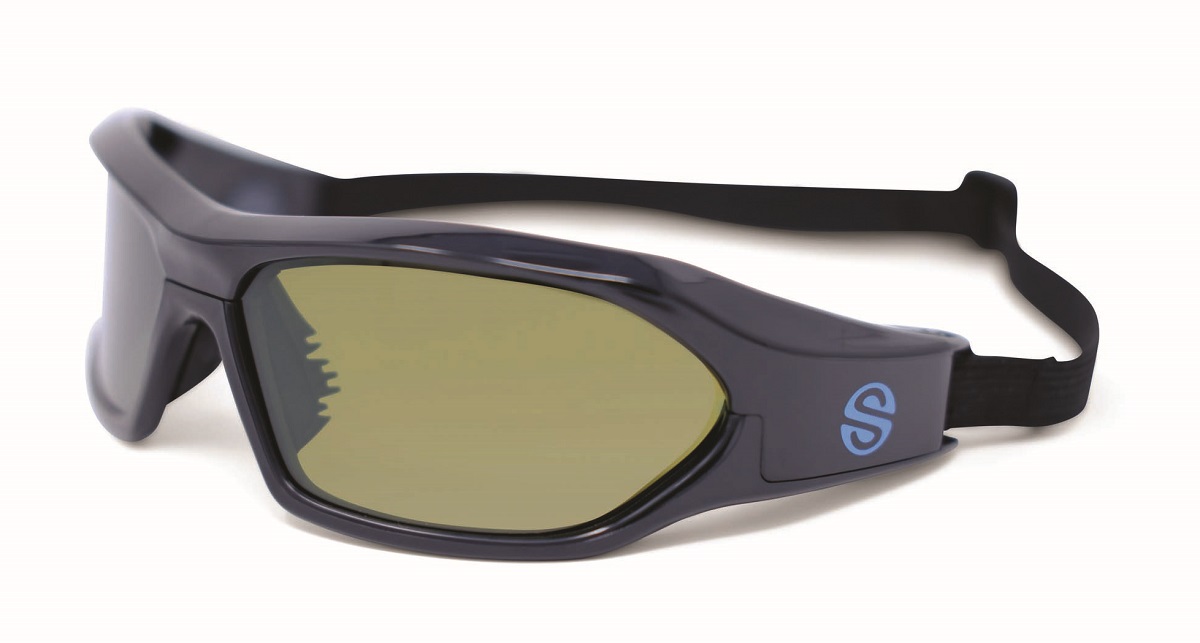
PitFit incorporates Senaptec’s strobe glasses as part of its neurocognitive exercises. Using liquid crystal technology, the lenses flicker between clear and opaque, removing visual information and forcing an individual to process more efficiently. / Photo courtesy Senaptec
That means workouts are often a combination of neck-centric strengthening exercises matched with ladder-type movements to improve hand-eye-foot coordination that are then paired with high-end virtual- and augmented-reality games and tasks based upon advanced biometrics, artificial intelligence, and data analytics.
PitFit has a custom-built sensory station, for example, created by Oregon-based Senaptec, a startup that’s bringing new visual training technologies to market that are specific to improving eye-to-brain connectivity. (Senaptec has the New York Yankees, Red Bull, and the Air Force on its client list.) PitFit’s station requires drivers to interact with moving images on a screen through activities that an article on thedrive.com compared to the arcade game Whac-A-Mole. Skill levels are then measured to help indicate the driver’s ability to make quick decisions under pressure.
Through high-end virtual and augmented reality games and tasks at the sensory station, you can assess your hand’s reactions to visual signals and find out how well you can see through distractions, judge depth, and track multiple objects in space. / Photo courtesy Senaptec
Race Trainer, another PitFit exclusive, is a homemade steering-resistance machine centered around a weighted steering wheel paired to pedals. A lighted control board behind the wheel prompts the driver to simulate a turn on the track, which then prompts the trainer to pull on resistance bands strapped to weighted headgear worn by the athlete. The exercise, according to PitFit, mimics the effects of those lateral g’s.
The light on PitFit’s Race Trainer serves as a reaction trainer—green means turn now—and it’s all about how the driver responds when the steering wheel and headgear are weighted. / Photo by Walter Kuhn
There are also low-tech training exercises. For instance, a trainer drops playing cards from chest height, and the driver has to try and grab one before the card hits the ground. The cards may fall in different directions, and this builds reaction-time skills that result in better, safer results on the track.
Mind + Matter
To get a sense of what a race car driver deals with, imagine this: You are out in the parking lot of your local shopping center in full sun at high noon in July wearing a pair of thick flannel sweatpants and sweatshirt, with gloves, shoes, and socks, atop an exercise bicycle that you must pedal hard enough to maintain a heart rate above 130 beats per minute. On your head is a helmet that has bungee cords attached, pulling your head randomly in four directions. With your left hand, you’re doing 15-pound bicep curls, while with your right hand you are throwing darts at a board every two seconds and each must hit the bull’s-eye. Meanwhile, a tennis ball machine is firing balls at you from 10 feet away, so you must duck out of the way to avoid being hit. To top it all off, through a set of earphones, you are being fed complex math problems that you must solve instantly or face the possibility of an electric shock if you answer incorrectly or if you miss the bullseye.
Taken as a whole, this hypothetical may border on the absurd, but each element gives us a sense, through ordinary tasks that we can all identify with, of the physical, reflexive, and mental rigors of driving a race car, along with the physical jeopardy that can result from bad decision-making.
“Drivers are always analyzing what they see on track or what information they are being fed from a spotter about track position or an engineer about strategy,” said Leo. “We spend a lot of time training a driver’s neuropathways to better cope with the physical and cognitive demands of racing by having them train at specific intensities, immediately followed by a cognitive skills test like repeating a pattern on a light board or visual recognition test, even sometimes adding some kind of auditory distraction to really create a chaotic environment while their heart and breath rates are still high.
Driver Zach Veach spends time at PitFit doing exercises designed to perfect hand-eye-foot coordination, which is part of the program’s brain training to improve success on the track. / Photo by Walter Kuhn
“The idea is to have them practice focusing on the task at hand to push beyond the physical stress,” elaborated Leo. “This trains a driver to cope with both the physical and mental demands they are required to exercise on track in competition.”
Consistency Is Key
That kind of focus may not be apparent to the spectator trackside or on television, but one need only look at the consistency of a top driver’s lap times to get the real picture. Over the course of a race, discounting laps where there is a yellow flag or a pit stop, it’s common to see a string of 25 or more lap times that never vary by more than half a second—the equivalent of throwing 25 darts in quick succession all within the bullseye.
While the romantic lore around a race car driver may be of a brazen daredevil driving by the seat of his or her pants, the reality is far from it. Drivers are highly fit athletes with astounding cognitive ability—meaning there is far more to winning a race than standing on the gas.
A Fitting Connection
Early in 2019, Matt Anderson, Curator of Transportation for The Henry Ford, along with other staffers, was on the phone with racing legend Lyn St. James. They were talking about themes and stories for Driven to Win: Racing in America, The Henry Ford’s permanent racing exhibition, then in progress. St. James, a longtime supporter and partner of The Henry Ford, was an integral source of ideas and insights related to Driven to Win since its conception—and she is one of the drivers showcased within the exhibit.
Lyn St. James (left), photographed by Michelle Andonian, instructs a student at her Complete Driver Academy in 2008. / THF58776
It was during this call that St. James recommended The Henry Ford investigate Jim Leo’s story of entrepreneurship and innovation. A who’s-who of auto racing had been having great success on the tracks using Leo’s PitFit Training approach, including drivers such as Scott Dixon, Tony Kanaan, Dario Franchitti, Will Power, Kasey Kahne, Sam Hornish, Jr., Larry Dixon, Morgan Lucas, Pippa Mann, Levi Jones, and James Hinchcliffe.
Soon after that call, Anderson and team were in Indianapolis, meeting Leo and touring his industry-leading motorsports training facility. “Jim couldn’t have been friendlier. He opened his doors and gave us an up-close look at his methods and machines,” noted Anderson, who admitted to being a bit starstruck when driver Pippa Mann walked into Leo’s gym to work out while The Henry Ford team was on-site.
“Jim had us try some of the physical and mental workouts,” Anderson continued. “We did our best, but, needless to say, none of us will be starting in the Indy 500 anytime soon.” The team decided then and there to incorporate elements of the PitFit program into the exhibition. Leo enthusiastically agreed to help adapt some of the training machines he uses into interactives for visitors to experience in Driven to Win. We also received assistance from Senaptec, who customized their app specifically for museum visitors.
“Our visitors will be able to use some of the same training machines, and some of the same sensory performance devices, that top drivers use,” Anderson said. “Once you realize the physical strength and mental acuity required of these racers, you’ll never doubt their athletic abilities again.”
George Tamayo is Creative Director at RACER Studio and has more than 20 years of experience in motorsports communications and marketing. This post was adapted from an article first published in the January–May 2020 issue of The Henry Ford Magazine.
Additional Readings:
- Driven to Win: Racing in America
- Eight Questions with Vaughn Gittin, Jr.
- Henry Ford's “Sweepstakes” Celebrates its 120th Anniversary
- 1965 Lotus-Ford Race Car
technology, sports, Henry Ford Museum, Driven to Win, The Henry Ford Magazine, race car drivers, racing, by George Tamayo
Peggy Hoyt: "Milliner and Dressmaker to the American Aristocracy"
 Our latest installation of What We Wore, featuring designer Peggy Hoyt. / THF189263
Our latest installation of What We Wore, featuring designer Peggy Hoyt. / THF189263
Our current What We Wore exhibit in Henry Ford Museum of American Innovation features garments and hats designed by Peggy Hoyt.
Advertisement for Peggy Hoyt, Inc., 1923. / THF624600
Peggy Hoyt, from “The Right Angle,” The Christy Walsh Syndicate, 1922. Gift of Colleen Cruise Reynolds. / THF626352, detail
Peggy Hoyt began her career making hats as a milliner’s apprentice and went on to become a highly successful fashion designer whose creations would rival those of Paris.
The Early Years
Peggy Hoyt was born Mary Alice Stephens in Saginaw, Michigan, in 1886, to Charles J. Stephens, a partner in a wholesale lumber business, and Carrie Stiff Stephens.
As a child, Mary Alice liked to draw and paint. She had a keen interest in clothes, often designing and making clothing for her large family of paper dolls. When her father’s illness resulted in his inability to resume his business activities, the family’s fortunes declined. A Civil War veteran, Charles Stephens was by 1905 living in the National Home for Disabled Soldiers in Hampton, Virginia, where he died in 1915.
Carrie Stephens moved with her daughter to New York City about 1900. Here, she felt she would have a better chance to get work that offered more than a bare living, as well as provide educational advantages for her daughter, Mary Alice. Though finding work turned out to be harder than anticipated, Carrie Stephens eventually found a job as a comparison shopper for a large department store. In the years following, Carrie Stephens worked her way up to a position as one of the highest salaried European buyers for the department store B. Altman.
In 1905, 18-year-old Mary Alice Stephens married Frank Hoyt in Monterey, Massachusetts—though the couple separated after only 18 months of marriage and Mary Alice then returned to New York City. Life on a 500-acre farm in the Berkshires didn’t suit Mary Alice—she missed the excitement of urban life. She and Frank Hoyt finally divorced in 1911; she kept her married name.
Becoming Peggy Hoyt
In her late teens, Hoyt worked as an apprentice in a Fifth Avenue millinery (hat) shop. By 1910, with a talent for design, a flair for business, and $300 borrowed from her mother, Hoyt established her own millinery shop in tiny quarters on upper Fifth Avenue, a shopping destination lined with luxurious stores. A year later, the business was successful enough to warrant an upgrade. She rented a larger room in the same building and hired an assistant. By 1915, Peggy Hoyt, Inc. was born.
In February 1918, Hoyt married Aubrey Eads—an officer in the American Naval Aviation Detachment who had recently returned after 14 months in France during World War I. Eads became her business partner.
A Leading American Designer
In the late 1910s, Hoyt moved her growing business into the elegant Phillip Rhinelander mansion at 16 East 55th Street in Manhattan, where she added women’s clothing to her offerings. The mansion, located in Manhattan’s Upper East Side shopping area, provided over 27,000 square feet of space with a stately white marble hall and a magnificent stairway. Hoyt transformed the mansion into one of the most exquisite fashion centers in America. The first floor became a reception room, salon, and fitting rooms. The second floor was devoted entirely to millinery. The top floors held workrooms and a lunchroom for employees.

Peggy Hoyt leased the Phillip Rhinelander mansion on at 16 East 55th Street, transforming it into a stunning setting for her increasingly successful salon. Gift of Colleen Cruise Reynolds. / THF120772, THF120770
A few years after she moved to the Rhinelander mansion, Peggy Hoyt ventured into theatrical costume design for a brief time. Her elegant costumes for Henry W. Savage’s revival of The Merry Widow in September 1921 were a huge success. The following year, she created costumes for the Savage musical The Clinging Vine.


Program for The Merry Widow. The operetta ran for 56 performances in fall of 1921 at the Knickerbocker Theatre in New York. Note the credits for Peggy Hoyt at the top of page 33 (you can click through to our Digital Collections to zoom in). / THF624648, THF624630, THF624638
Hoyt quickly became one of the foremost American designers of gowns and millinery. Her designs were creative and unique, employing her signature pastels, rhinestone ornaments, and handkerchief hems. Hoyt designed each of the hundreds of gowns and hats in her shop, taking great pride in her work. For nearly twenty years, Hoyt dressed a small, but exclusive, clientele in every large American city.
Advertisement: "Peggy Hoyt: New York's Smartest Millinery and Dressmaking Establishment," April 1925. / THF624602
Peggy Hoyt discussed the type of garment, color, style, and fabric with her client, and then sketched the designs. Hoyt oversaw the next steps in the workroom, where staff cut and sewed the garment. Clients had their very own dress form, an adjustable mannequin on which Hoyt’s designs came to life. At the client’s next appointment, the garment was taken to the front of the salon for the final fitting.
A Peggy Hoyt Client: Elizabeth Parke Firestone

Elizabeth Parke Firestone, about 1927. Gift of Mrs. Harvey Firestone, Jr. / THF119839
Receipt for Mrs. H.S. Firestone, Jr. from Peggy Hoyt, Inc., 1934. Gift of Martha F. Ford. / THF626330
Elizabeth Parke Firestone of Akron, Ohio—wife of tire magnate Harvey S. Firestone, Jr.—was among the wealthy women who frequented Peggy Hoyt’s salon. Mrs. Firestone traveled to New York, where Hoyt would confer with her client and then create the beautiful garments and hats for Mrs. Firestone shown here.
Evening dress designed by Peggy Hoyt, 1928. Gift of Mrs. Harvey Firestone, Jr. / THF6688
Evening dress designed by Peggy Hoyt, 1928-1929. Gift of Mrs. Harvey Firestone, Jr. / THF6720
Chemise dress designed by Peggy Hoyt, 1929. Gift of Mrs. Harvey Firestone, Jr. / THF6710
Evening dress designed by Peggy Hoyt, 1931. Gift of Mrs. Harvey Firestone, Jr. / THF6731
Cloche designed by Peggy Hoyt, 1920-1935. Gift of Martha Firestone Ford and Anne Firestone Ball. / THF17330
Cloche designed by Peggy Hoyt, 1925-1936. Gift of Mrs. Harvey Firestone, Jr. / THF30500
Picture hat designed by Peggy Hoyt, 1925-1935. Gift of Mrs. Harvey Firestone, Jr. / THF6754
Picture hat designed by Peggy Hoyt, 1926-1936. Gift of Mrs. Harvey Firestone, Jr. / THF6747
An Unhappy Ending

Peggy Hoyt, Inc., box lid, 1925-1935. Gift of Colleen Cruise Reynolds. / THF188547
At its height, Peggy Hoyt, Inc., earned over $1 million annually and had hundreds of employees. Yet Peggy Hoyt, Inc.—and Peggy herself—would not survive the depression of the 1930s as the faltering economy brought down the thriving business.
Peggy Hoyt died by suicide on October 26, 1937 (though her family maintained that her death resulted from pneumonia). Hoyt, who had an intense dislike of personal publicity, had asked her mother and husband to honor her wishes for privacy upon her death. At the request of Hoyt’s employees, her husband did consent to a small service at the Little Church Around the Corner (the Church of the Transfiguration) before Hoyt’s body was brought to Detroit and laid to rest in Elmwood Cemetery.
Peggy Hoyt, Inc., briefly continued after Hoyt’s passing, with her mother and husband maintaining the salon until its bankruptcy and liquidation in 1939–1940.
Jeanine Head Miller is Curator of Domestic Life at The Henry Ford. Many thanks to Stacy McNally, Local History & Genealogy Librarian at the Public Libraries of Saginaw, and Gil Gallagher, curatorial volunteer at The Henry Ford, for their meticulous research assistance on Peggy Hoyt. Many thanks also to Sophia Kloc, Office Administrator for Historical Resources at The Henry Ford, for editorial preparation assistance with this post.
Firestone family, New York, 20th century, 19th century, women's history, What We Wore, Michigan, making, Henry Ford Museum, hats, fashion, Elizabeth Parke Firestone, design, by Jeanine Head Miller

